Managing the legal environment: Commonwealth Bank
VerifiedAdded on 2023/01/03
|24
|7200
|356
AI Summary
This paper analyzes the legal governance, management, and relationship issues that affect the Commonwealth Bank. It also discusses specific legislation and areas of high legal risk for the organization.
Contribute Materials
Your contribution can guide someone’s learning journey. Share your
documents today.
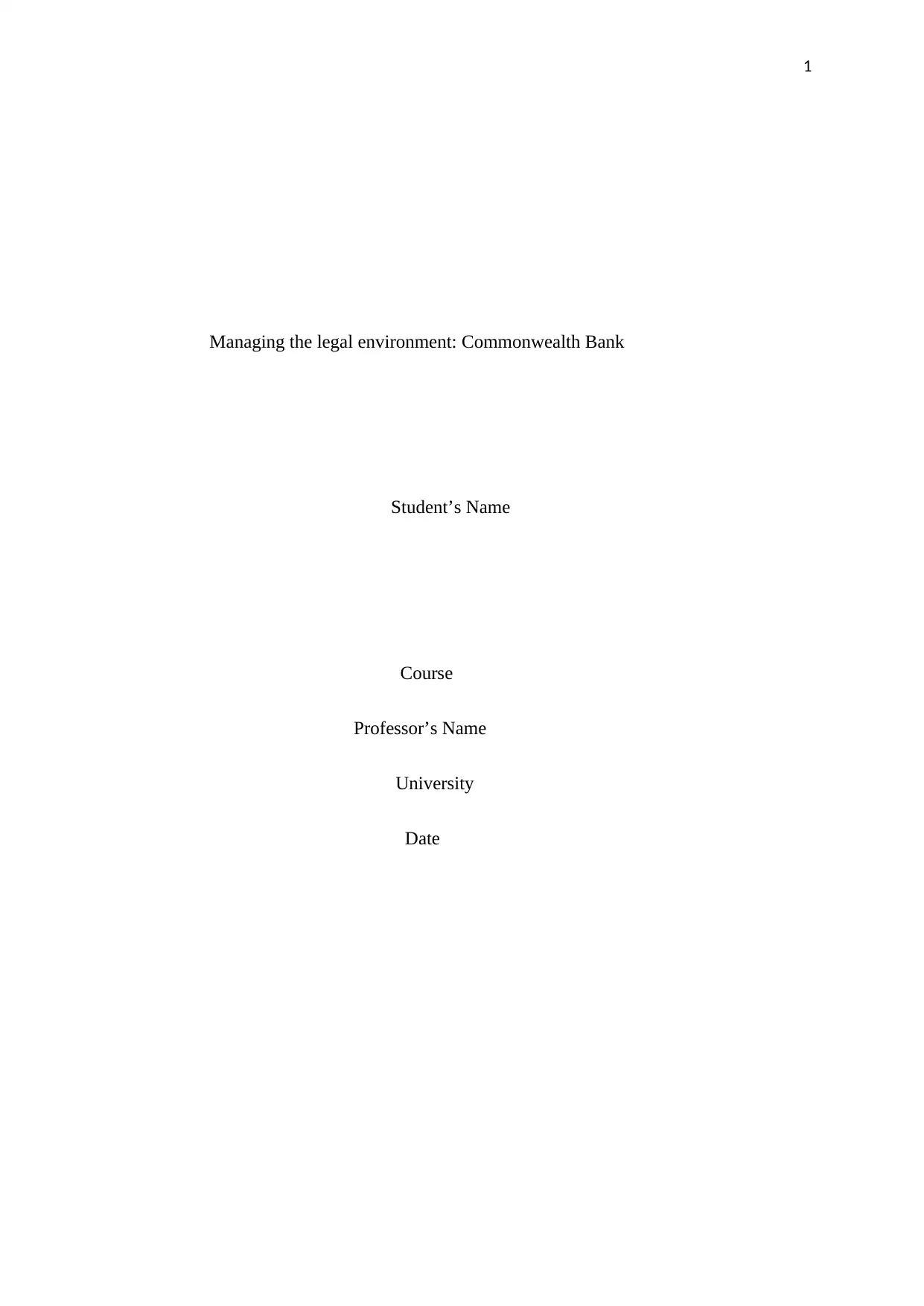
1
Managing the legal environment: Commonwealth Bank
Student’s Name
Course
Professor’s Name
University
Date
Managing the legal environment: Commonwealth Bank
Student’s Name
Course
Professor’s Name
University
Date
Secure Best Marks with AI Grader
Need help grading? Try our AI Grader for instant feedback on your assignments.
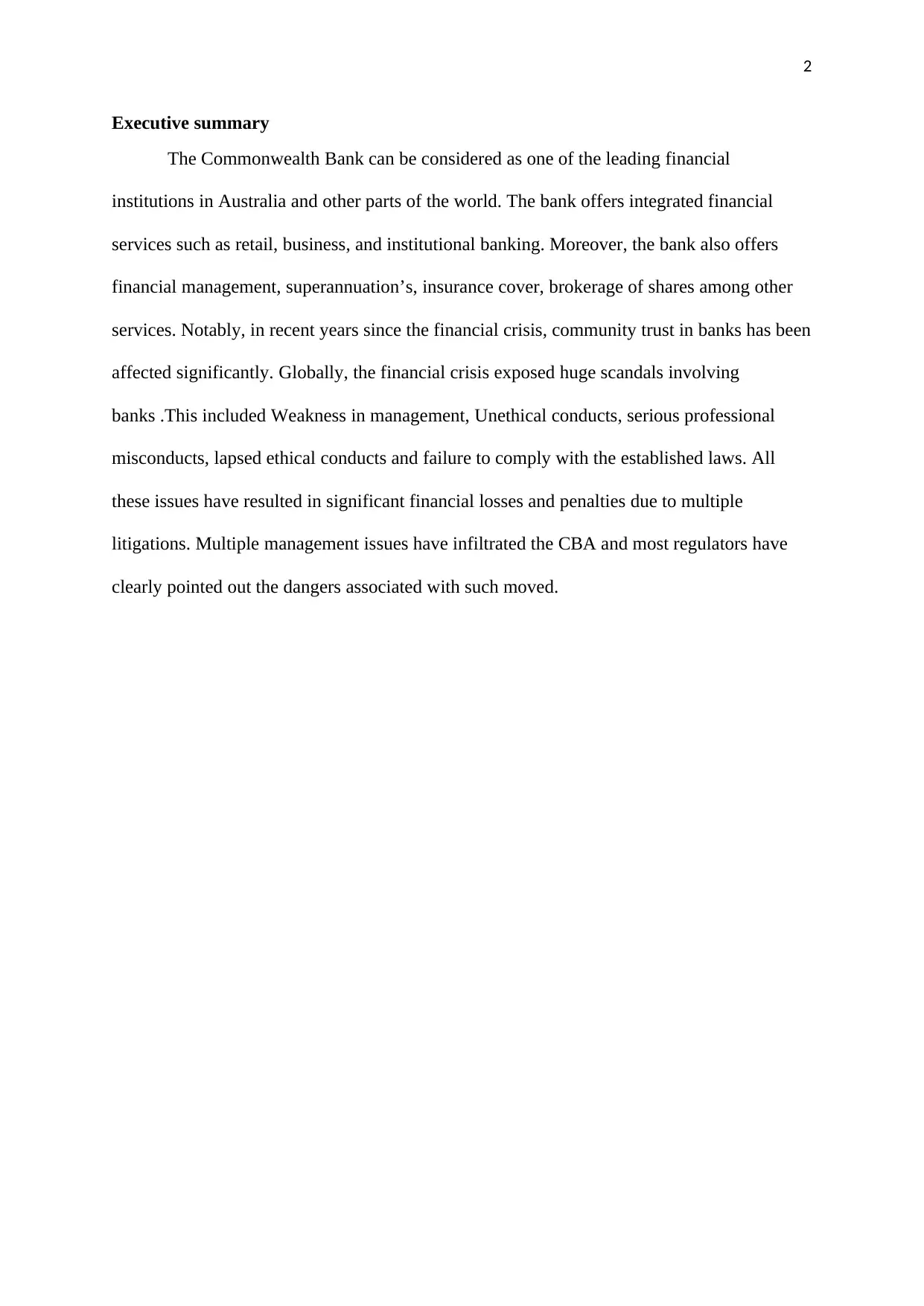
2
Executive summary
The Commonwealth Bank can be considered as one of the leading financial
institutions in Australia and other parts of the world. The bank offers integrated financial
services such as retail, business, and institutional banking. Moreover, the bank also offers
financial management, superannuation’s, insurance cover, brokerage of shares among other
services. Notably, in recent years since the financial crisis, community trust in banks has been
affected significantly. Globally, the financial crisis exposed huge scandals involving
banks .This included Weakness in management, Unethical conducts, serious professional
misconducts, lapsed ethical conducts and failure to comply with the established laws. All
these issues have resulted in significant financial losses and penalties due to multiple
litigations. Multiple management issues have infiltrated the CBA and most regulators have
clearly pointed out the dangers associated with such moved.
Executive summary
The Commonwealth Bank can be considered as one of the leading financial
institutions in Australia and other parts of the world. The bank offers integrated financial
services such as retail, business, and institutional banking. Moreover, the bank also offers
financial management, superannuation’s, insurance cover, brokerage of shares among other
services. Notably, in recent years since the financial crisis, community trust in banks has been
affected significantly. Globally, the financial crisis exposed huge scandals involving
banks .This included Weakness in management, Unethical conducts, serious professional
misconducts, lapsed ethical conducts and failure to comply with the established laws. All
these issues have resulted in significant financial losses and penalties due to multiple
litigations. Multiple management issues have infiltrated the CBA and most regulators have
clearly pointed out the dangers associated with such moved.
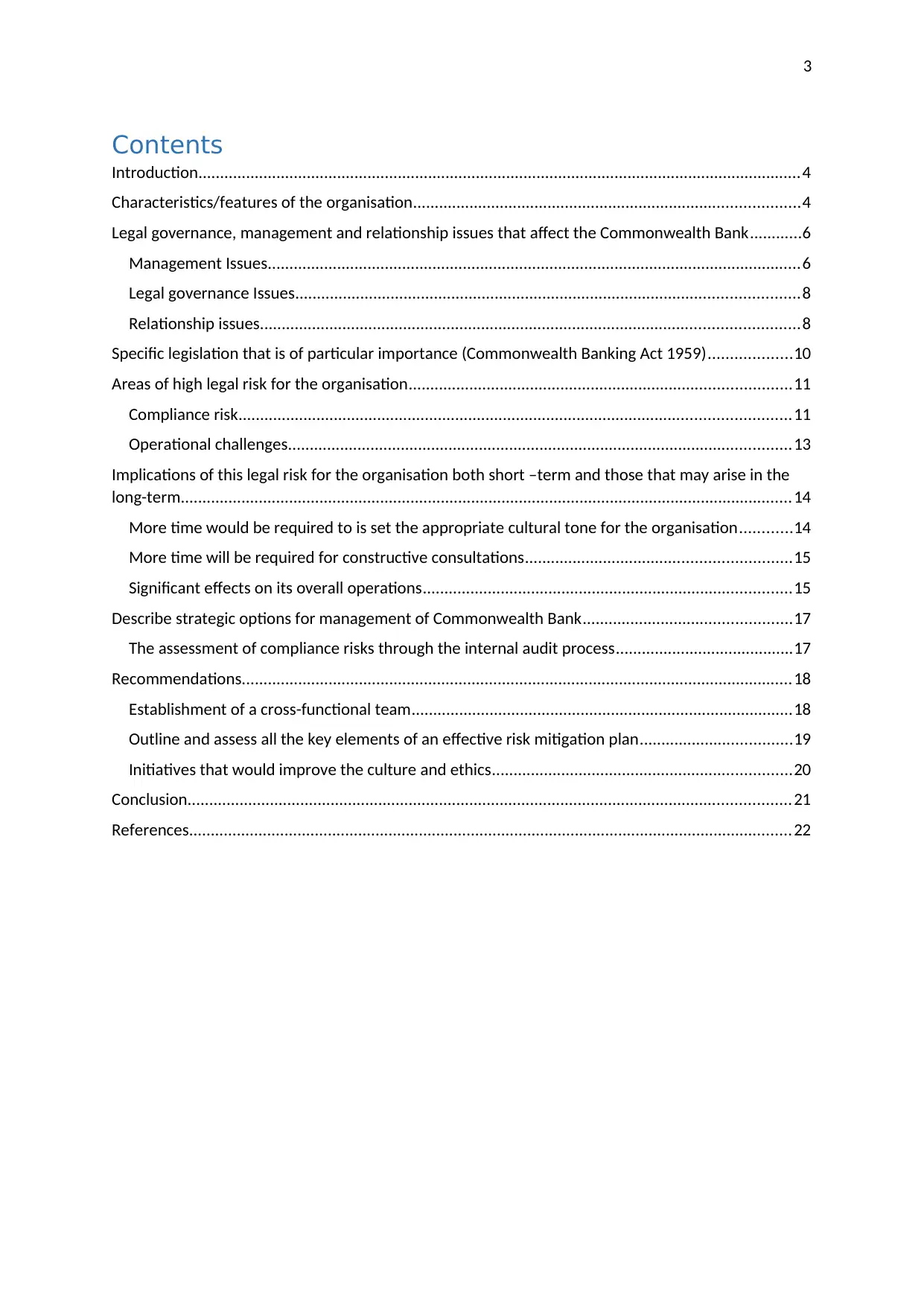
3
Contents
Introduction...........................................................................................................................................4
Characteristics/features of the organisation.........................................................................................4
Legal governance, management and relationship issues that affect the Commonwealth Bank............6
Management Issues...........................................................................................................................6
Legal governance Issues....................................................................................................................8
Relationship issues............................................................................................................................8
Specific legislation that is of particular importance (Commonwealth Banking Act 1959)...................10
Areas of high legal risk for the organisation........................................................................................11
Compliance risk...............................................................................................................................11
Operational challenges....................................................................................................................13
Implications of this legal risk for the organisation both short –term and those that may arise in the
long-term.............................................................................................................................................14
More time would be required to is set the appropriate cultural tone for the organisation............14
More time will be required for constructive consultations.............................................................15
Significant effects on its overall operations.....................................................................................15
Describe strategic options for management of Commonwealth Bank................................................17
The assessment of compliance risks through the internal audit process.........................................17
Recommendations...............................................................................................................................18
Establishment of a cross-functional team........................................................................................18
Outline and assess all the key elements of an effective risk mitigation plan...................................19
Initiatives that would improve the culture and ethics.....................................................................20
Conclusion...........................................................................................................................................21
References...........................................................................................................................................22
Contents
Introduction...........................................................................................................................................4
Characteristics/features of the organisation.........................................................................................4
Legal governance, management and relationship issues that affect the Commonwealth Bank............6
Management Issues...........................................................................................................................6
Legal governance Issues....................................................................................................................8
Relationship issues............................................................................................................................8
Specific legislation that is of particular importance (Commonwealth Banking Act 1959)...................10
Areas of high legal risk for the organisation........................................................................................11
Compliance risk...............................................................................................................................11
Operational challenges....................................................................................................................13
Implications of this legal risk for the organisation both short –term and those that may arise in the
long-term.............................................................................................................................................14
More time would be required to is set the appropriate cultural tone for the organisation............14
More time will be required for constructive consultations.............................................................15
Significant effects on its overall operations.....................................................................................15
Describe strategic options for management of Commonwealth Bank................................................17
The assessment of compliance risks through the internal audit process.........................................17
Recommendations...............................................................................................................................18
Establishment of a cross-functional team........................................................................................18
Outline and assess all the key elements of an effective risk mitigation plan...................................19
Initiatives that would improve the culture and ethics.....................................................................20
Conclusion...........................................................................................................................................21
References...........................................................................................................................................22
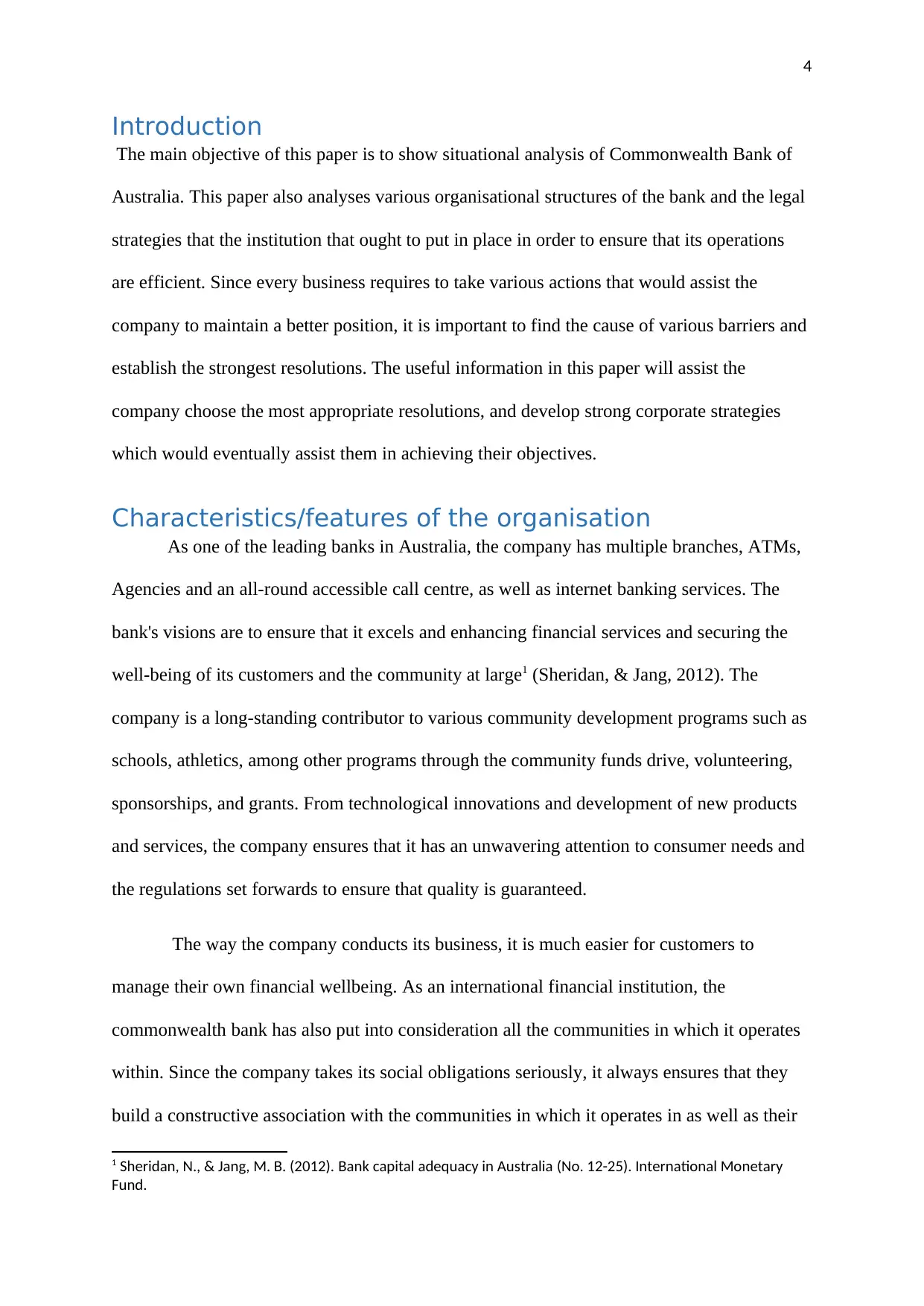
4
Introduction
The main objective of this paper is to show situational analysis of Commonwealth Bank of
Australia. This paper also analyses various organisational structures of the bank and the legal
strategies that the institution that ought to put in place in order to ensure that its operations
are efficient. Since every business requires to take various actions that would assist the
company to maintain a better position, it is important to find the cause of various barriers and
establish the strongest resolutions. The useful information in this paper will assist the
company choose the most appropriate resolutions, and develop strong corporate strategies
which would eventually assist them in achieving their objectives.
Characteristics/features of the organisation
As one of the leading banks in Australia, the company has multiple branches, ATMs,
Agencies and an all-round accessible call centre, as well as internet banking services. The
bank's visions are to ensure that it excels and enhancing financial services and securing the
well-being of its customers and the community at large1 (Sheridan, & Jang, 2012). The
company is a long-standing contributor to various community development programs such as
schools, athletics, among other programs through the community funds drive, volunteering,
sponsorships, and grants. From technological innovations and development of new products
and services, the company ensures that it has an unwavering attention to consumer needs and
the regulations set forwards to ensure that quality is guaranteed.
The way the company conducts its business, it is much easier for customers to
manage their own financial wellbeing. As an international financial institution, the
commonwealth bank has also put into consideration all the communities in which it operates
within. Since the company takes its social obligations seriously, it always ensures that they
build a constructive association with the communities in which it operates in as well as their
1 Sheridan, N., & Jang, M. B. (2012). Bank capital adequacy in Australia (No. 12-25). International Monetary
Fund.
Introduction
The main objective of this paper is to show situational analysis of Commonwealth Bank of
Australia. This paper also analyses various organisational structures of the bank and the legal
strategies that the institution that ought to put in place in order to ensure that its operations
are efficient. Since every business requires to take various actions that would assist the
company to maintain a better position, it is important to find the cause of various barriers and
establish the strongest resolutions. The useful information in this paper will assist the
company choose the most appropriate resolutions, and develop strong corporate strategies
which would eventually assist them in achieving their objectives.
Characteristics/features of the organisation
As one of the leading banks in Australia, the company has multiple branches, ATMs,
Agencies and an all-round accessible call centre, as well as internet banking services. The
bank's visions are to ensure that it excels and enhancing financial services and securing the
well-being of its customers and the community at large1 (Sheridan, & Jang, 2012). The
company is a long-standing contributor to various community development programs such as
schools, athletics, among other programs through the community funds drive, volunteering,
sponsorships, and grants. From technological innovations and development of new products
and services, the company ensures that it has an unwavering attention to consumer needs and
the regulations set forwards to ensure that quality is guaranteed.
The way the company conducts its business, it is much easier for customers to
manage their own financial wellbeing. As an international financial institution, the
commonwealth bank has also put into consideration all the communities in which it operates
within. Since the company takes its social obligations seriously, it always ensures that they
build a constructive association with the communities in which it operates in as well as their
1 Sheridan, N., & Jang, M. B. (2012). Bank capital adequacy in Australia (No. 12-25). International Monetary
Fund.
Secure Best Marks with AI Grader
Need help grading? Try our AI Grader for instant feedback on your assignments.
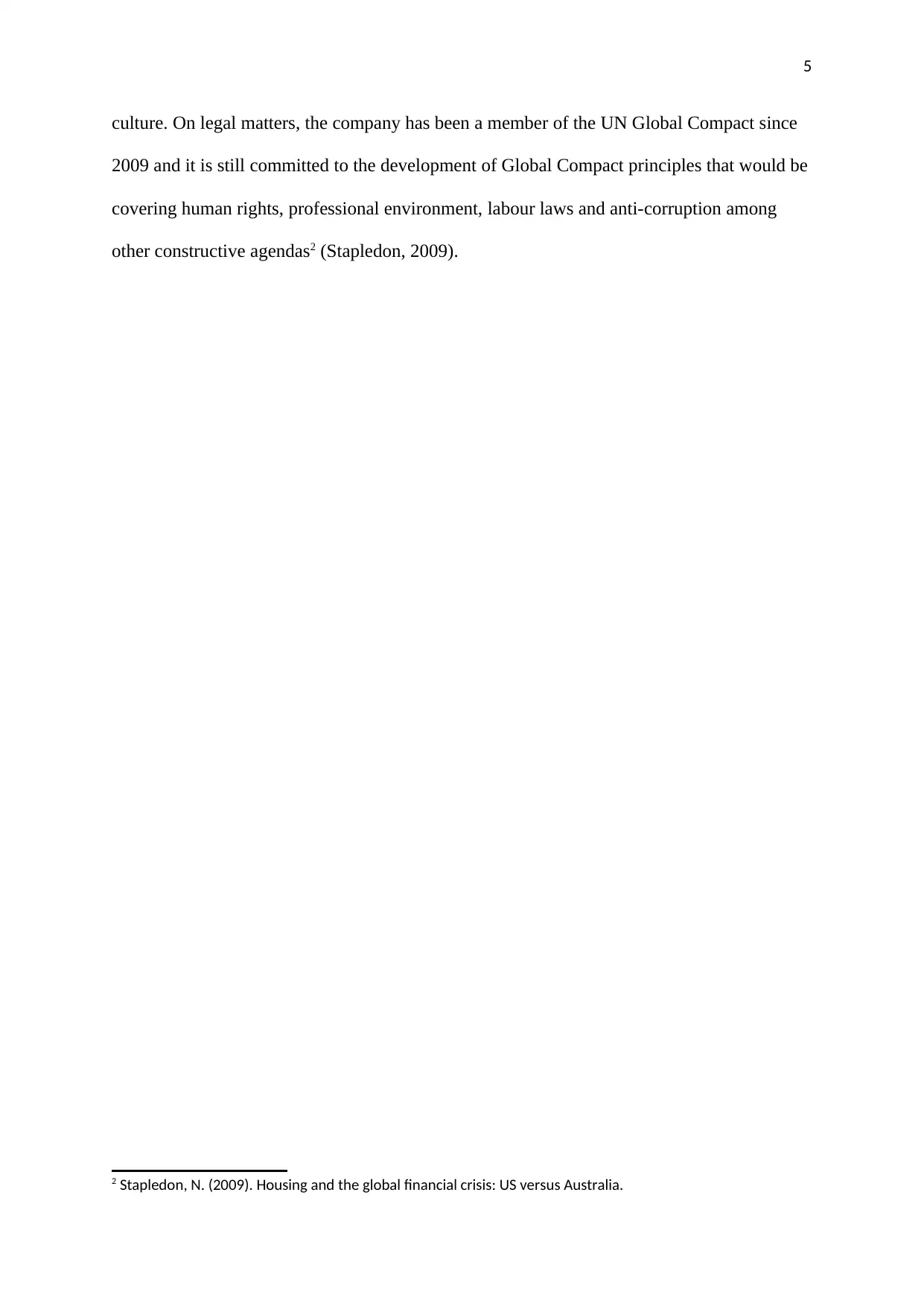
5
culture. On legal matters, the company has been a member of the UN Global Compact since
2009 and it is still committed to the development of Global Compact principles that would be
covering human rights, professional environment, labour laws and anti-corruption among
other constructive agendas2 (Stapledon, 2009).
2 Stapledon, N. (2009). Housing and the global financial crisis: US versus Australia.
culture. On legal matters, the company has been a member of the UN Global Compact since
2009 and it is still committed to the development of Global Compact principles that would be
covering human rights, professional environment, labour laws and anti-corruption among
other constructive agendas2 (Stapledon, 2009).
2 Stapledon, N. (2009). Housing and the global financial crisis: US versus Australia.
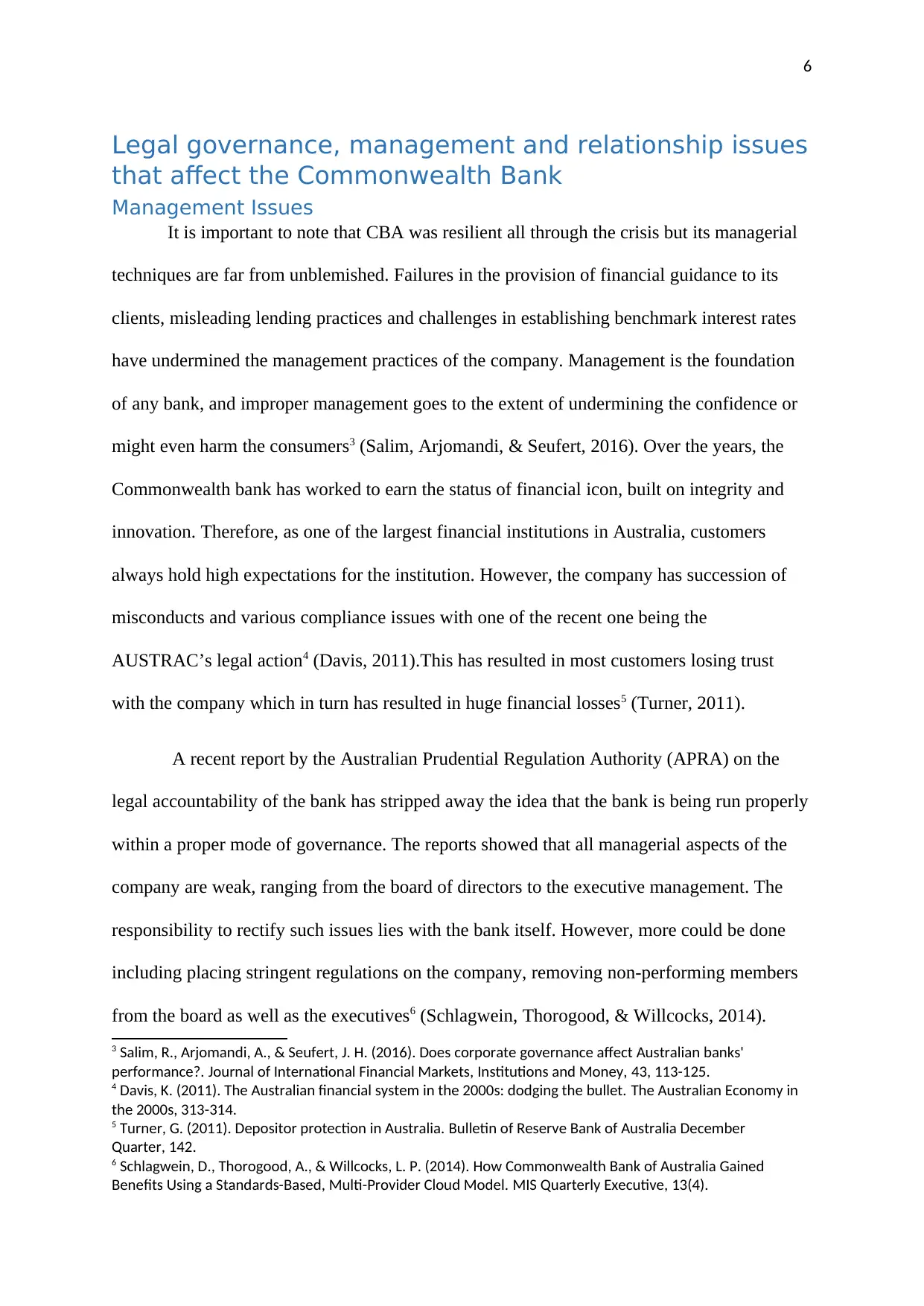
6
Legal governance, management and relationship issues
that affect the Commonwealth Bank
Management Issues
It is important to note that CBA was resilient all through the crisis but its managerial
techniques are far from unblemished. Failures in the provision of financial guidance to its
clients, misleading lending practices and challenges in establishing benchmark interest rates
have undermined the management practices of the company. Management is the foundation
of any bank, and improper management goes to the extent of undermining the confidence or
might even harm the consumers3 (Salim, Arjomandi, & Seufert, 2016). Over the years, the
Commonwealth bank has worked to earn the status of financial icon, built on integrity and
innovation. Therefore, as one of the largest financial institutions in Australia, customers
always hold high expectations for the institution. However, the company has succession of
misconducts and various compliance issues with one of the recent one being the
AUSTRAC’s legal action4 (Davis, 2011).This has resulted in most customers losing trust
with the company which in turn has resulted in huge financial losses5 (Turner, 2011).
A recent report by the Australian Prudential Regulation Authority (APRA) on the
legal accountability of the bank has stripped away the idea that the bank is being run properly
within a proper mode of governance. The reports showed that all managerial aspects of the
company are weak, ranging from the board of directors to the executive management. The
responsibility to rectify such issues lies with the bank itself. However, more could be done
including placing stringent regulations on the company, removing non-performing members
from the board as well as the executives6 (Schlagwein, Thorogood, & Willcocks, 2014).
3 Salim, R., Arjomandi, A., & Seufert, J. H. (2016). Does corporate governance affect Australian banks'
performance?. Journal of International Financial Markets, Institutions and Money, 43, 113-125.
4 Davis, K. (2011). The Australian financial system in the 2000s: dodging the bullet. The Australian Economy in
the 2000s, 313-314.
5 Turner, G. (2011). Depositor protection in Australia. Bulletin of Reserve Bank of Australia December
Quarter, 142.
6 Schlagwein, D., Thorogood, A., & Willcocks, L. P. (2014). How Commonwealth Bank of Australia Gained
Benefits Using a Standards-Based, Multi-Provider Cloud Model. MIS Quarterly Executive, 13(4).
Legal governance, management and relationship issues
that affect the Commonwealth Bank
Management Issues
It is important to note that CBA was resilient all through the crisis but its managerial
techniques are far from unblemished. Failures in the provision of financial guidance to its
clients, misleading lending practices and challenges in establishing benchmark interest rates
have undermined the management practices of the company. Management is the foundation
of any bank, and improper management goes to the extent of undermining the confidence or
might even harm the consumers3 (Salim, Arjomandi, & Seufert, 2016). Over the years, the
Commonwealth bank has worked to earn the status of financial icon, built on integrity and
innovation. Therefore, as one of the largest financial institutions in Australia, customers
always hold high expectations for the institution. However, the company has succession of
misconducts and various compliance issues with one of the recent one being the
AUSTRAC’s legal action4 (Davis, 2011).This has resulted in most customers losing trust
with the company which in turn has resulted in huge financial losses5 (Turner, 2011).
A recent report by the Australian Prudential Regulation Authority (APRA) on the
legal accountability of the bank has stripped away the idea that the bank is being run properly
within a proper mode of governance. The reports showed that all managerial aspects of the
company are weak, ranging from the board of directors to the executive management. The
responsibility to rectify such issues lies with the bank itself. However, more could be done
including placing stringent regulations on the company, removing non-performing members
from the board as well as the executives6 (Schlagwein, Thorogood, & Willcocks, 2014).
3 Salim, R., Arjomandi, A., & Seufert, J. H. (2016). Does corporate governance affect Australian banks'
performance?. Journal of International Financial Markets, Institutions and Money, 43, 113-125.
4 Davis, K. (2011). The Australian financial system in the 2000s: dodging the bullet. The Australian Economy in
the 2000s, 313-314.
5 Turner, G. (2011). Depositor protection in Australia. Bulletin of Reserve Bank of Australia December
Quarter, 142.
6 Schlagwein, D., Thorogood, A., & Willcocks, L. P. (2014). How Commonwealth Bank of Australia Gained
Benefits Using a Standards-Based, Multi-Provider Cloud Model. MIS Quarterly Executive, 13(4).

7
Paraphrase This Document
Need a fresh take? Get an instant paraphrase of this document with our AI Paraphraser
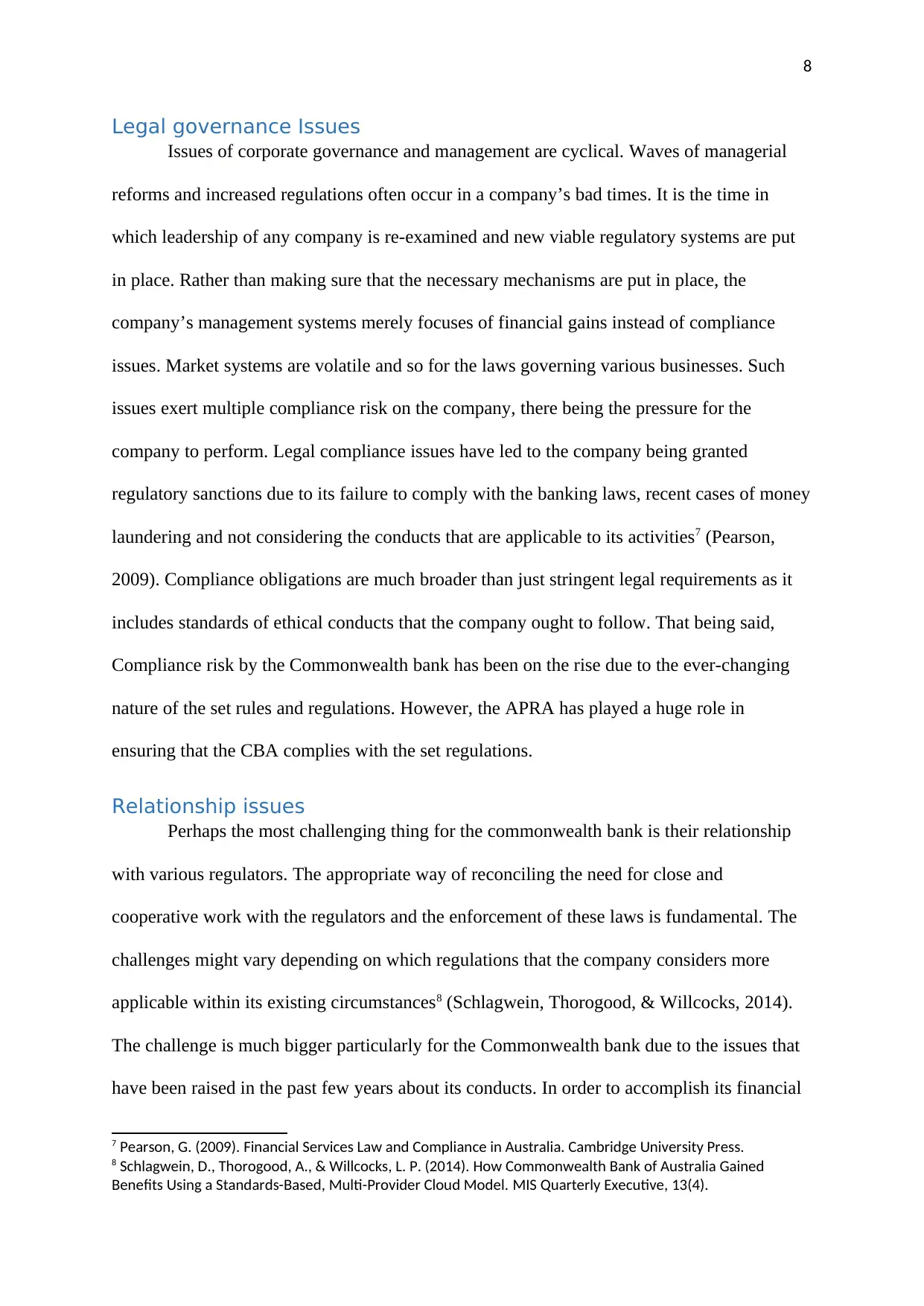
8
Legal governance Issues
Issues of corporate governance and management are cyclical. Waves of managerial
reforms and increased regulations often occur in a company’s bad times. It is the time in
which leadership of any company is re-examined and new viable regulatory systems are put
in place. Rather than making sure that the necessary mechanisms are put in place, the
company’s management systems merely focuses of financial gains instead of compliance
issues. Market systems are volatile and so for the laws governing various businesses. Such
issues exert multiple compliance risk on the company, there being the pressure for the
company to perform. Legal compliance issues have led to the company being granted
regulatory sanctions due to its failure to comply with the banking laws, recent cases of money
laundering and not considering the conducts that are applicable to its activities7 (Pearson,
2009). Compliance obligations are much broader than just stringent legal requirements as it
includes standards of ethical conducts that the company ought to follow. That being said,
Compliance risk by the Commonwealth bank has been on the rise due to the ever-changing
nature of the set rules and regulations. However, the APRA has played a huge role in
ensuring that the CBA complies with the set regulations.
Relationship issues
Perhaps the most challenging thing for the commonwealth bank is their relationship
with various regulators. The appropriate way of reconciling the need for close and
cooperative work with the regulators and the enforcement of these laws is fundamental. The
challenges might vary depending on which regulations that the company considers more
applicable within its existing circumstances8 (Schlagwein, Thorogood, & Willcocks, 2014).
The challenge is much bigger particularly for the Commonwealth bank due to the issues that
have been raised in the past few years about its conducts. In order to accomplish its financial
7 Pearson, G. (2009). Financial Services Law and Compliance in Australia. Cambridge University Press.
8 Schlagwein, D., Thorogood, A., & Willcocks, L. P. (2014). How Commonwealth Bank of Australia Gained
Benefits Using a Standards-Based, Multi-Provider Cloud Model. MIS Quarterly Executive, 13(4).
Legal governance Issues
Issues of corporate governance and management are cyclical. Waves of managerial
reforms and increased regulations often occur in a company’s bad times. It is the time in
which leadership of any company is re-examined and new viable regulatory systems are put
in place. Rather than making sure that the necessary mechanisms are put in place, the
company’s management systems merely focuses of financial gains instead of compliance
issues. Market systems are volatile and so for the laws governing various businesses. Such
issues exert multiple compliance risk on the company, there being the pressure for the
company to perform. Legal compliance issues have led to the company being granted
regulatory sanctions due to its failure to comply with the banking laws, recent cases of money
laundering and not considering the conducts that are applicable to its activities7 (Pearson,
2009). Compliance obligations are much broader than just stringent legal requirements as it
includes standards of ethical conducts that the company ought to follow. That being said,
Compliance risk by the Commonwealth bank has been on the rise due to the ever-changing
nature of the set rules and regulations. However, the APRA has played a huge role in
ensuring that the CBA complies with the set regulations.
Relationship issues
Perhaps the most challenging thing for the commonwealth bank is their relationship
with various regulators. The appropriate way of reconciling the need for close and
cooperative work with the regulators and the enforcement of these laws is fundamental. The
challenges might vary depending on which regulations that the company considers more
applicable within its existing circumstances8 (Schlagwein, Thorogood, & Willcocks, 2014).
The challenge is much bigger particularly for the Commonwealth bank due to the issues that
have been raised in the past few years about its conducts. In order to accomplish its financial
7 Pearson, G. (2009). Financial Services Law and Compliance in Australia. Cambridge University Press.
8 Schlagwein, D., Thorogood, A., & Willcocks, L. P. (2014). How Commonwealth Bank of Australia Gained
Benefits Using a Standards-Based, Multi-Provider Cloud Model. MIS Quarterly Executive, 13(4).
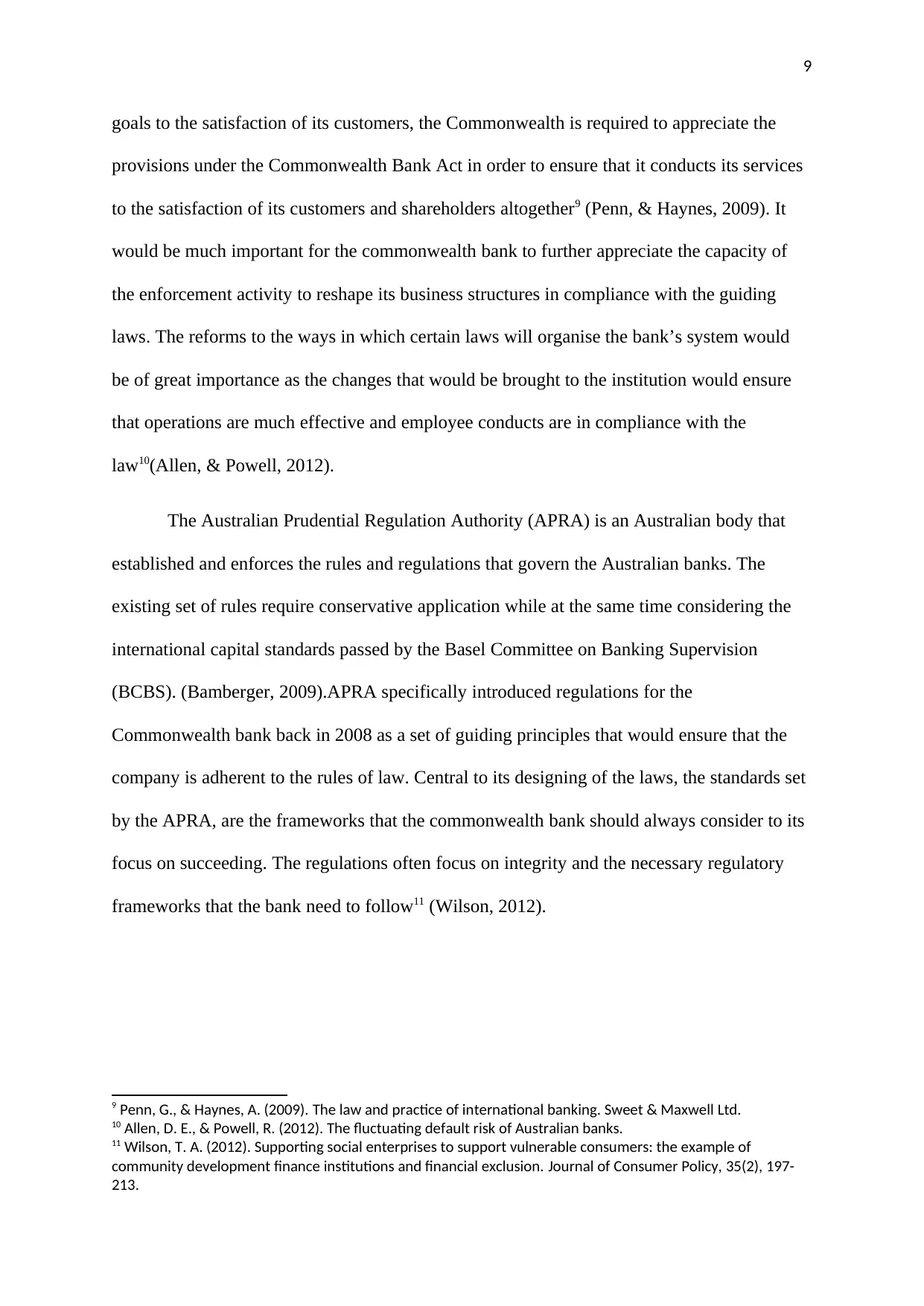
9
goals to the satisfaction of its customers, the Commonwealth is required to appreciate the
provisions under the Commonwealth Bank Act in order to ensure that it conducts its services
to the satisfaction of its customers and shareholders altogether9 (Penn, & Haynes, 2009). It
would be much important for the commonwealth bank to further appreciate the capacity of
the enforcement activity to reshape its business structures in compliance with the guiding
laws. The reforms to the ways in which certain laws will organise the bank’s system would
be of great importance as the changes that would be brought to the institution would ensure
that operations are much effective and employee conducts are in compliance with the
law10(Allen, & Powell, 2012).
The Australian Prudential Regulation Authority (APRA) is an Australian body that
established and enforces the rules and regulations that govern the Australian banks. The
existing set of rules require conservative application while at the same time considering the
international capital standards passed by the Basel Committee on Banking Supervision
(BCBS). (Bamberger, 2009).APRA specifically introduced regulations for the
Commonwealth bank back in 2008 as a set of guiding principles that would ensure that the
company is adherent to the rules of law. Central to its designing of the laws, the standards set
by the APRA, are the frameworks that the commonwealth bank should always consider to its
focus on succeeding. The regulations often focus on integrity and the necessary regulatory
frameworks that the bank need to follow11 (Wilson, 2012).
9 Penn, G., & Haynes, A. (2009). The law and practice of international banking. Sweet & Maxwell Ltd.
10 Allen, D. E., & Powell, R. (2012). The fluctuating default risk of Australian banks.
11 Wilson, T. A. (2012). Supporting social enterprises to support vulnerable consumers: the example of
community development finance institutions and financial exclusion. Journal of Consumer Policy, 35(2), 197-
213.
goals to the satisfaction of its customers, the Commonwealth is required to appreciate the
provisions under the Commonwealth Bank Act in order to ensure that it conducts its services
to the satisfaction of its customers and shareholders altogether9 (Penn, & Haynes, 2009). It
would be much important for the commonwealth bank to further appreciate the capacity of
the enforcement activity to reshape its business structures in compliance with the guiding
laws. The reforms to the ways in which certain laws will organise the bank’s system would
be of great importance as the changes that would be brought to the institution would ensure
that operations are much effective and employee conducts are in compliance with the
law10(Allen, & Powell, 2012).
The Australian Prudential Regulation Authority (APRA) is an Australian body that
established and enforces the rules and regulations that govern the Australian banks. The
existing set of rules require conservative application while at the same time considering the
international capital standards passed by the Basel Committee on Banking Supervision
(BCBS). (Bamberger, 2009).APRA specifically introduced regulations for the
Commonwealth bank back in 2008 as a set of guiding principles that would ensure that the
company is adherent to the rules of law. Central to its designing of the laws, the standards set
by the APRA, are the frameworks that the commonwealth bank should always consider to its
focus on succeeding. The regulations often focus on integrity and the necessary regulatory
frameworks that the bank need to follow11 (Wilson, 2012).
9 Penn, G., & Haynes, A. (2009). The law and practice of international banking. Sweet & Maxwell Ltd.
10 Allen, D. E., & Powell, R. (2012). The fluctuating default risk of Australian banks.
11 Wilson, T. A. (2012). Supporting social enterprises to support vulnerable consumers: the example of
community development finance institutions and financial exclusion. Journal of Consumer Policy, 35(2), 197-
213.
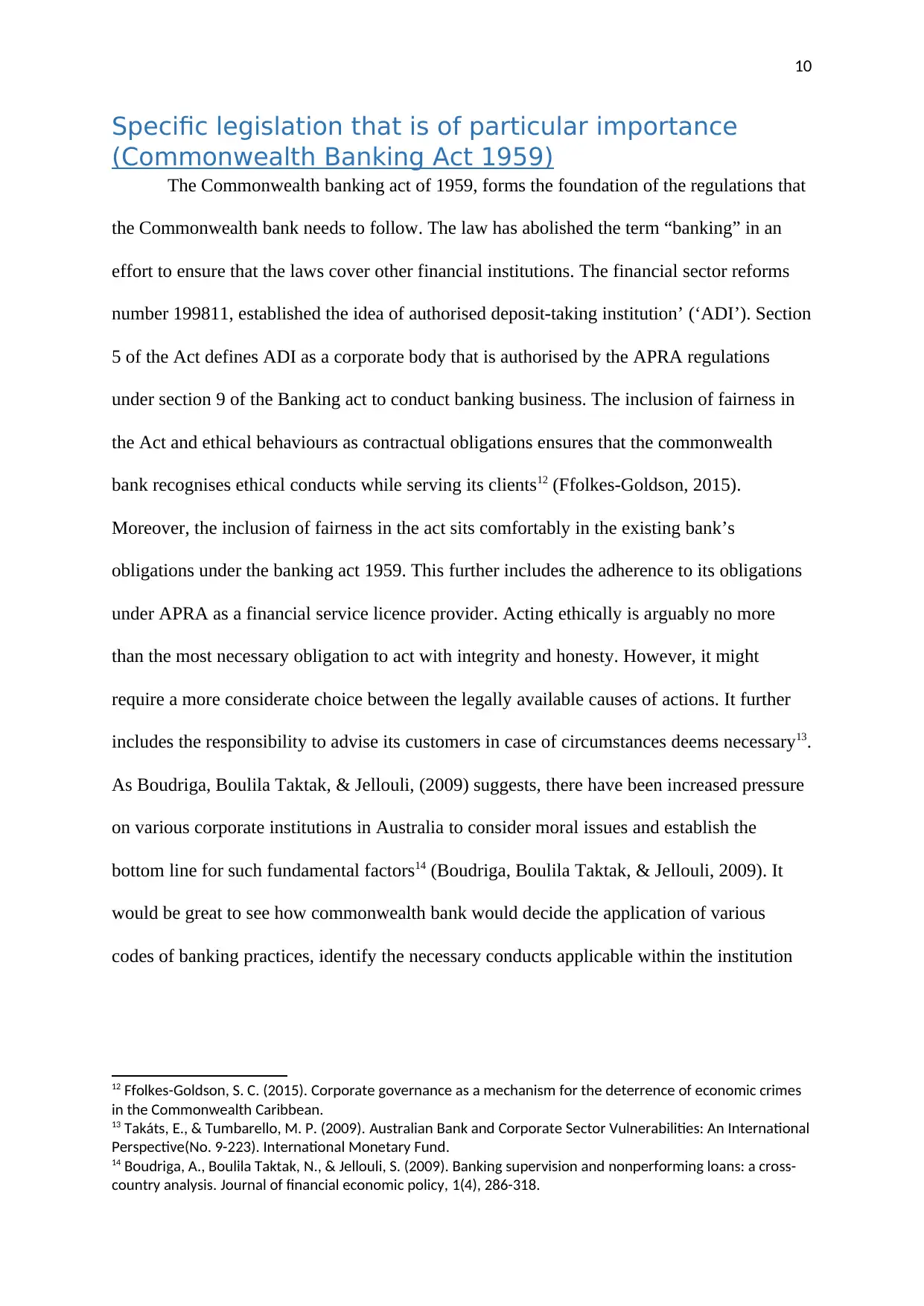
10
Specific legislation that is of particular importance
(Commonwealth Banking Act 1959)
The Commonwealth banking act of 1959, forms the foundation of the regulations that
the Commonwealth bank needs to follow. The law has abolished the term “banking” in an
effort to ensure that the laws cover other financial institutions. The financial sector reforms
number 199811, established the idea of authorised deposit-taking institution’ (‘ADI’). Section
5 of the Act defines ADI as a corporate body that is authorised by the APRA regulations
under section 9 of the Banking act to conduct banking business. The inclusion of fairness in
the Act and ethical behaviours as contractual obligations ensures that the commonwealth
bank recognises ethical conducts while serving its clients12 (Ffolkes-Goldson, 2015).
Moreover, the inclusion of fairness in the act sits comfortably in the existing bank’s
obligations under the banking act 1959. This further includes the adherence to its obligations
under APRA as a financial service licence provider. Acting ethically is arguably no more
than the most necessary obligation to act with integrity and honesty. However, it might
require a more considerate choice between the legally available causes of actions. It further
includes the responsibility to advise its customers in case of circumstances deems necessary13.
As Boudriga, Boulila Taktak, & Jellouli, (2009) suggests, there have been increased pressure
on various corporate institutions in Australia to consider moral issues and establish the
bottom line for such fundamental factors14 (Boudriga, Boulila Taktak, & Jellouli, 2009). It
would be great to see how commonwealth bank would decide the application of various
codes of banking practices, identify the necessary conducts applicable within the institution
12 Ffolkes-Goldson, S. C. (2015). Corporate governance as a mechanism for the deterrence of economic crimes
in the Commonwealth Caribbean.
13 Takáts, E., & Tumbarello, M. P. (2009). Australian Bank and Corporate Sector Vulnerabilities: An International
Perspective(No. 9-223). International Monetary Fund.
14 Boudriga, A., Boulila Taktak, N., & Jellouli, S. (2009). Banking supervision and nonperforming loans: a cross-
country analysis. Journal of financial economic policy, 1(4), 286-318.
Specific legislation that is of particular importance
(Commonwealth Banking Act 1959)
The Commonwealth banking act of 1959, forms the foundation of the regulations that
the Commonwealth bank needs to follow. The law has abolished the term “banking” in an
effort to ensure that the laws cover other financial institutions. The financial sector reforms
number 199811, established the idea of authorised deposit-taking institution’ (‘ADI’). Section
5 of the Act defines ADI as a corporate body that is authorised by the APRA regulations
under section 9 of the Banking act to conduct banking business. The inclusion of fairness in
the Act and ethical behaviours as contractual obligations ensures that the commonwealth
bank recognises ethical conducts while serving its clients12 (Ffolkes-Goldson, 2015).
Moreover, the inclusion of fairness in the act sits comfortably in the existing bank’s
obligations under the banking act 1959. This further includes the adherence to its obligations
under APRA as a financial service licence provider. Acting ethically is arguably no more
than the most necessary obligation to act with integrity and honesty. However, it might
require a more considerate choice between the legally available causes of actions. It further
includes the responsibility to advise its customers in case of circumstances deems necessary13.
As Boudriga, Boulila Taktak, & Jellouli, (2009) suggests, there have been increased pressure
on various corporate institutions in Australia to consider moral issues and establish the
bottom line for such fundamental factors14 (Boudriga, Boulila Taktak, & Jellouli, 2009). It
would be great to see how commonwealth bank would decide the application of various
codes of banking practices, identify the necessary conducts applicable within the institution
12 Ffolkes-Goldson, S. C. (2015). Corporate governance as a mechanism for the deterrence of economic crimes
in the Commonwealth Caribbean.
13 Takáts, E., & Tumbarello, M. P. (2009). Australian Bank and Corporate Sector Vulnerabilities: An International
Perspective(No. 9-223). International Monetary Fund.
14 Boudriga, A., Boulila Taktak, N., & Jellouli, S. (2009). Banking supervision and nonperforming loans: a cross-
country analysis. Journal of financial economic policy, 1(4), 286-318.
Secure Best Marks with AI Grader
Need help grading? Try our AI Grader for instant feedback on your assignments.
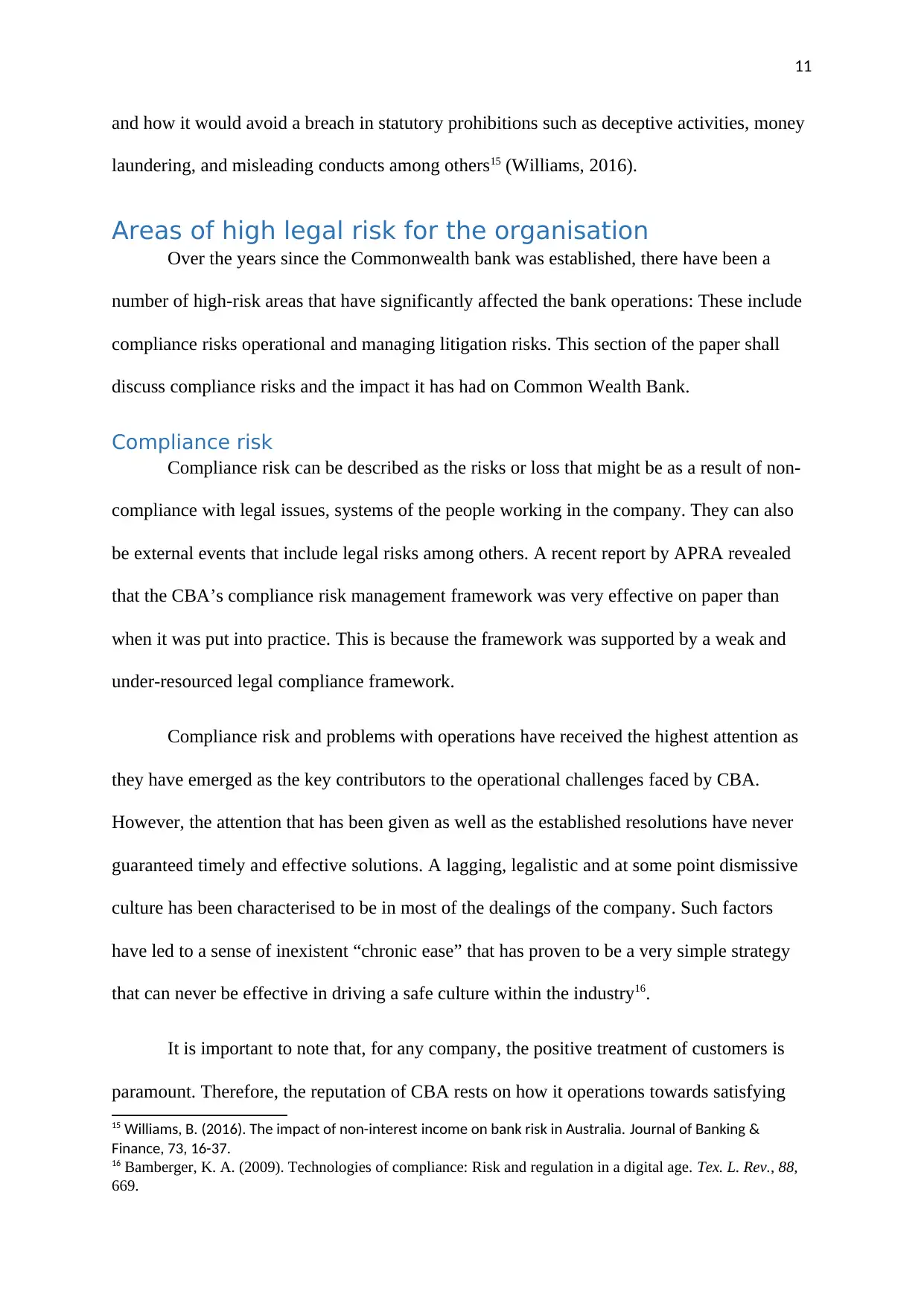
11
and how it would avoid a breach in statutory prohibitions such as deceptive activities, money
laundering, and misleading conducts among others15 (Williams, 2016).
Areas of high legal risk for the organisation
Over the years since the Commonwealth bank was established, there have been a
number of high-risk areas that have significantly affected the bank operations: These include
compliance risks operational and managing litigation risks. This section of the paper shall
discuss compliance risks and the impact it has had on Common Wealth Bank.
Compliance risk
Compliance risk can be described as the risks or loss that might be as a result of non-
compliance with legal issues, systems of the people working in the company. They can also
be external events that include legal risks among others. A recent report by APRA revealed
that the CBA’s compliance risk management framework was very effective on paper than
when it was put into practice. This is because the framework was supported by a weak and
under-resourced legal compliance framework.
Compliance risk and problems with operations have received the highest attention as
they have emerged as the key contributors to the operational challenges faced by CBA.
However, the attention that has been given as well as the established resolutions have never
guaranteed timely and effective solutions. A lagging, legalistic and at some point dismissive
culture has been characterised to be in most of the dealings of the company. Such factors
have led to a sense of inexistent “chronic ease” that has proven to be a very simple strategy
that can never be effective in driving a safe culture within the industry16.
It is important to note that, for any company, the positive treatment of customers is
paramount. Therefore, the reputation of CBA rests on how it operations towards satisfying
15 Williams, B. (2016). The impact of non-interest income on bank risk in Australia. Journal of Banking &
Finance, 73, 16-37.
16 Bamberger, K. A. (2009). Technologies of compliance: Risk and regulation in a digital age. Tex. L. Rev., 88,
669.
and how it would avoid a breach in statutory prohibitions such as deceptive activities, money
laundering, and misleading conducts among others15 (Williams, 2016).
Areas of high legal risk for the organisation
Over the years since the Commonwealth bank was established, there have been a
number of high-risk areas that have significantly affected the bank operations: These include
compliance risks operational and managing litigation risks. This section of the paper shall
discuss compliance risks and the impact it has had on Common Wealth Bank.
Compliance risk
Compliance risk can be described as the risks or loss that might be as a result of non-
compliance with legal issues, systems of the people working in the company. They can also
be external events that include legal risks among others. A recent report by APRA revealed
that the CBA’s compliance risk management framework was very effective on paper than
when it was put into practice. This is because the framework was supported by a weak and
under-resourced legal compliance framework.
Compliance risk and problems with operations have received the highest attention as
they have emerged as the key contributors to the operational challenges faced by CBA.
However, the attention that has been given as well as the established resolutions have never
guaranteed timely and effective solutions. A lagging, legalistic and at some point dismissive
culture has been characterised to be in most of the dealings of the company. Such factors
have led to a sense of inexistent “chronic ease” that has proven to be a very simple strategy
that can never be effective in driving a safe culture within the industry16.
It is important to note that, for any company, the positive treatment of customers is
paramount. Therefore, the reputation of CBA rests on how it operations towards satisfying
15 Williams, B. (2016). The impact of non-interest income on bank risk in Australia. Journal of Banking &
Finance, 73, 16-37.
16 Bamberger, K. A. (2009). Technologies of compliance: Risk and regulation in a digital age. Tex. L. Rev., 88,
669.
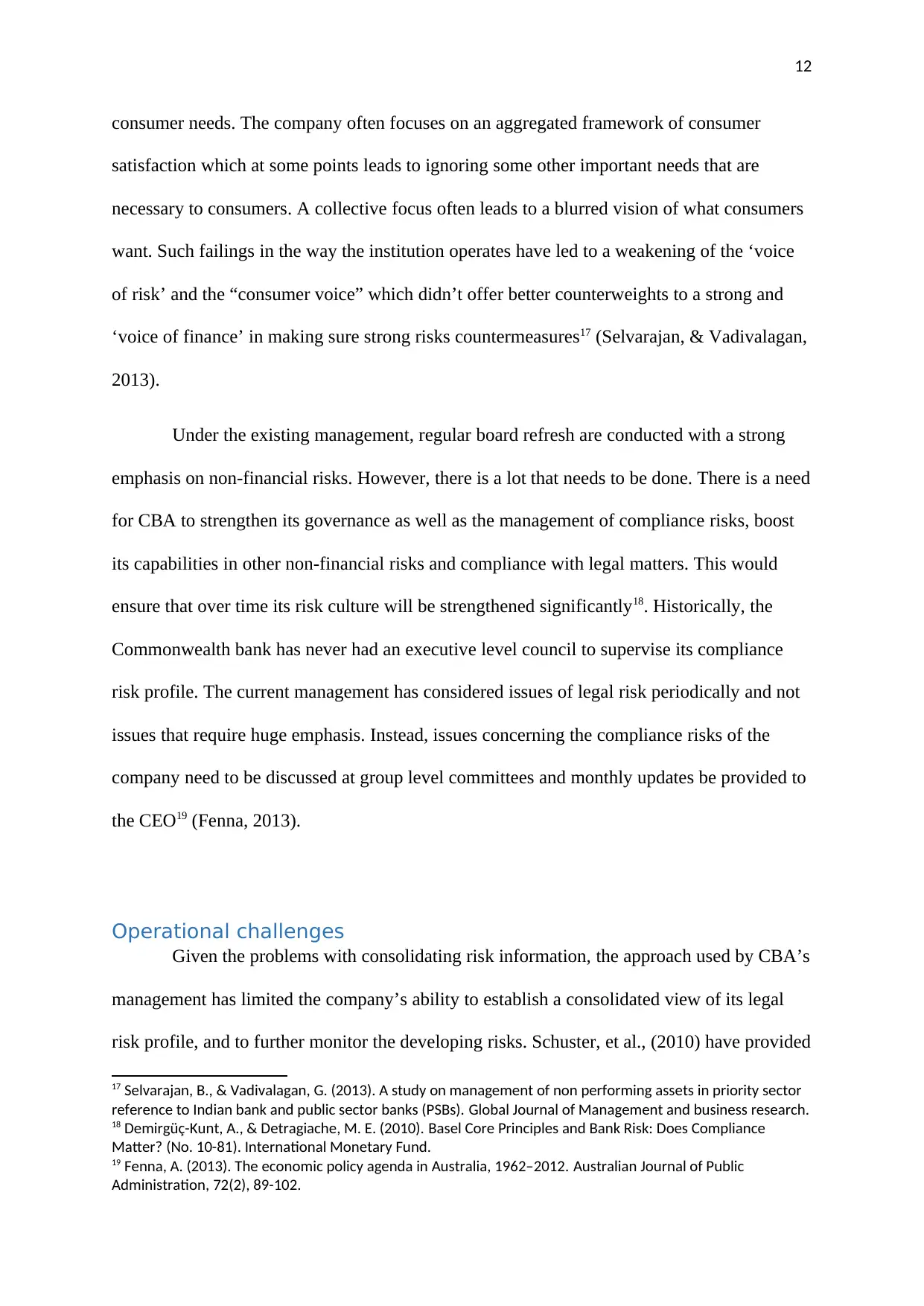
12
consumer needs. The company often focuses on an aggregated framework of consumer
satisfaction which at some points leads to ignoring some other important needs that are
necessary to consumers. A collective focus often leads to a blurred vision of what consumers
want. Such failings in the way the institution operates have led to a weakening of the ‘voice
of risk’ and the “consumer voice” which didn’t offer better counterweights to a strong and
‘voice of finance’ in making sure strong risks countermeasures17 (Selvarajan, & Vadivalagan,
2013).
Under the existing management, regular board refresh are conducted with a strong
emphasis on non-financial risks. However, there is a lot that needs to be done. There is a need
for CBA to strengthen its governance as well as the management of compliance risks, boost
its capabilities in other non-financial risks and compliance with legal matters. This would
ensure that over time its risk culture will be strengthened significantly18. Historically, the
Commonwealth bank has never had an executive level council to supervise its compliance
risk profile. The current management has considered issues of legal risk periodically and not
issues that require huge emphasis. Instead, issues concerning the compliance risks of the
company need to be discussed at group level committees and monthly updates be provided to
the CEO19 (Fenna, 2013).
Operational challenges
Given the problems with consolidating risk information, the approach used by CBA’s
management has limited the company’s ability to establish a consolidated view of its legal
risk profile, and to further monitor the developing risks. Schuster, et al., (2010) have provided
17 Selvarajan, B., & Vadivalagan, G. (2013). A study on management of non performing assets in priority sector
reference to Indian bank and public sector banks (PSBs). Global Journal of Management and business research.
18 Demirgüç-Kunt, A., & Detragiache, M. E. (2010). Basel Core Principles and Bank Risk: Does Compliance
Matter? (No. 10-81). International Monetary Fund.
19 Fenna, A. (2013). The economic policy agenda in Australia, 1962–2012. Australian Journal of Public
Administration, 72(2), 89-102.
consumer needs. The company often focuses on an aggregated framework of consumer
satisfaction which at some points leads to ignoring some other important needs that are
necessary to consumers. A collective focus often leads to a blurred vision of what consumers
want. Such failings in the way the institution operates have led to a weakening of the ‘voice
of risk’ and the “consumer voice” which didn’t offer better counterweights to a strong and
‘voice of finance’ in making sure strong risks countermeasures17 (Selvarajan, & Vadivalagan,
2013).
Under the existing management, regular board refresh are conducted with a strong
emphasis on non-financial risks. However, there is a lot that needs to be done. There is a need
for CBA to strengthen its governance as well as the management of compliance risks, boost
its capabilities in other non-financial risks and compliance with legal matters. This would
ensure that over time its risk culture will be strengthened significantly18. Historically, the
Commonwealth bank has never had an executive level council to supervise its compliance
risk profile. The current management has considered issues of legal risk periodically and not
issues that require huge emphasis. Instead, issues concerning the compliance risks of the
company need to be discussed at group level committees and monthly updates be provided to
the CEO19 (Fenna, 2013).
Operational challenges
Given the problems with consolidating risk information, the approach used by CBA’s
management has limited the company’s ability to establish a consolidated view of its legal
risk profile, and to further monitor the developing risks. Schuster, et al., (2010) have provided
17 Selvarajan, B., & Vadivalagan, G. (2013). A study on management of non performing assets in priority sector
reference to Indian bank and public sector banks (PSBs). Global Journal of Management and business research.
18 Demirgüç-Kunt, A., & Detragiache, M. E. (2010). Basel Core Principles and Bank Risk: Does Compliance
Matter? (No. 10-81). International Monetary Fund.
19 Fenna, A. (2013). The economic policy agenda in Australia, 1962–2012. Australian Journal of Public
Administration, 72(2), 89-102.
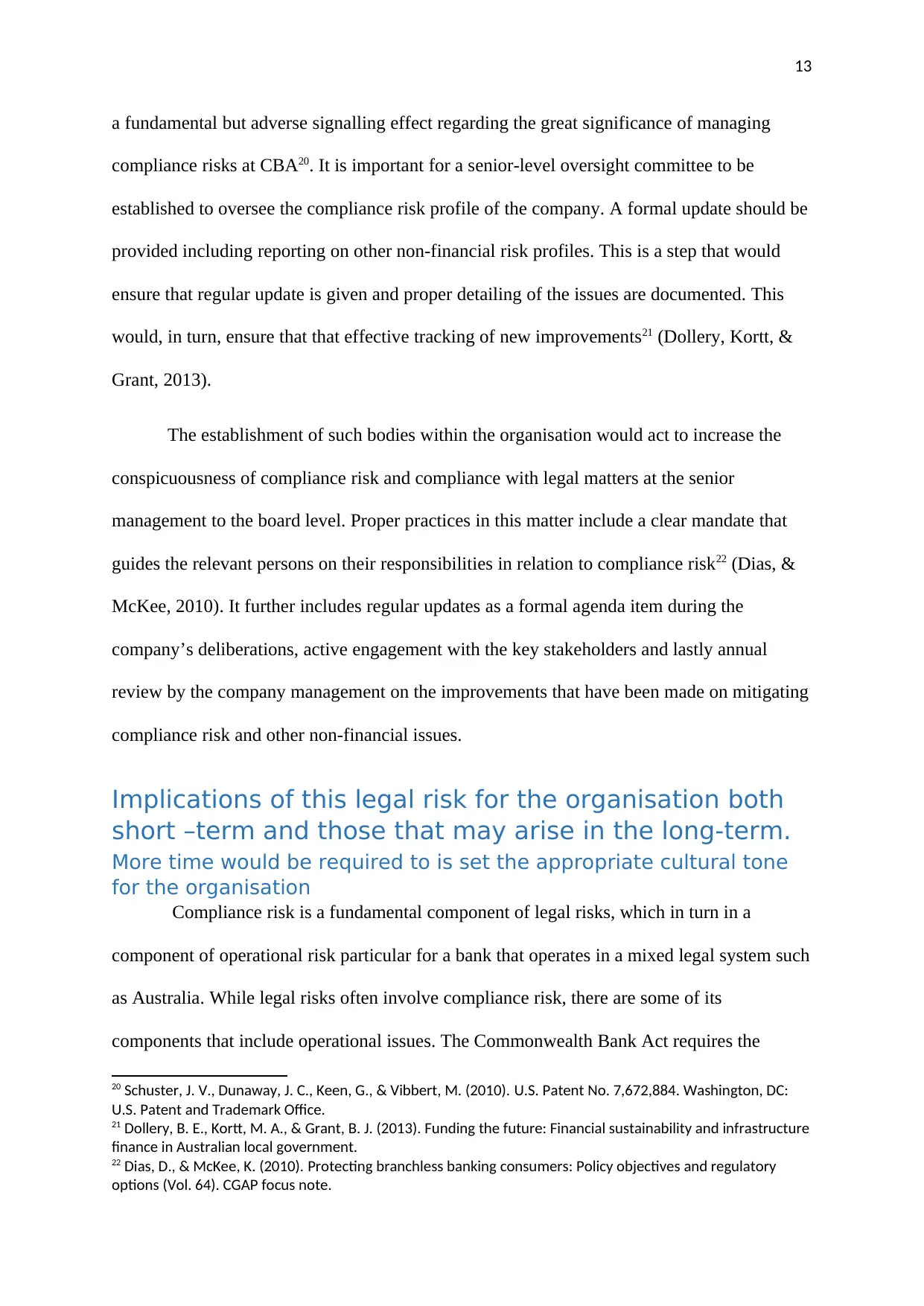
13
a fundamental but adverse signalling effect regarding the great significance of managing
compliance risks at CBA20. It is important for a senior-level oversight committee to be
established to oversee the compliance risk profile of the company. A formal update should be
provided including reporting on other non-financial risk profiles. This is a step that would
ensure that regular update is given and proper detailing of the issues are documented. This
would, in turn, ensure that that effective tracking of new improvements21 (Dollery, Kortt, &
Grant, 2013).
The establishment of such bodies within the organisation would act to increase the
conspicuousness of compliance risk and compliance with legal matters at the senior
management to the board level. Proper practices in this matter include a clear mandate that
guides the relevant persons on their responsibilities in relation to compliance risk22 (Dias, &
McKee, 2010). It further includes regular updates as a formal agenda item during the
company’s deliberations, active engagement with the key stakeholders and lastly annual
review by the company management on the improvements that have been made on mitigating
compliance risk and other non-financial issues.
Implications of this legal risk for the organisation both
short –term and those that may arise in the long-term.
More time would be required to is set the appropriate cultural tone
for the organisation
Compliance risk is a fundamental component of legal risks, which in turn in a
component of operational risk particular for a bank that operates in a mixed legal system such
as Australia. While legal risks often involve compliance risk, there are some of its
components that include operational issues. The Commonwealth Bank Act requires the
20 Schuster, J. V., Dunaway, J. C., Keen, G., & Vibbert, M. (2010). U.S. Patent No. 7,672,884. Washington, DC:
U.S. Patent and Trademark Office.
21 Dollery, B. E., Kortt, M. A., & Grant, B. J. (2013). Funding the future: Financial sustainability and infrastructure
finance in Australian local government.
22 Dias, D., & McKee, K. (2010). Protecting branchless banking consumers: Policy objectives and regulatory
options (Vol. 64). CGAP focus note.
a fundamental but adverse signalling effect regarding the great significance of managing
compliance risks at CBA20. It is important for a senior-level oversight committee to be
established to oversee the compliance risk profile of the company. A formal update should be
provided including reporting on other non-financial risk profiles. This is a step that would
ensure that regular update is given and proper detailing of the issues are documented. This
would, in turn, ensure that that effective tracking of new improvements21 (Dollery, Kortt, &
Grant, 2013).
The establishment of such bodies within the organisation would act to increase the
conspicuousness of compliance risk and compliance with legal matters at the senior
management to the board level. Proper practices in this matter include a clear mandate that
guides the relevant persons on their responsibilities in relation to compliance risk22 (Dias, &
McKee, 2010). It further includes regular updates as a formal agenda item during the
company’s deliberations, active engagement with the key stakeholders and lastly annual
review by the company management on the improvements that have been made on mitigating
compliance risk and other non-financial issues.
Implications of this legal risk for the organisation both
short –term and those that may arise in the long-term.
More time would be required to is set the appropriate cultural tone
for the organisation
Compliance risk is a fundamental component of legal risks, which in turn in a
component of operational risk particular for a bank that operates in a mixed legal system such
as Australia. While legal risks often involve compliance risk, there are some of its
components that include operational issues. The Commonwealth Bank Act requires the
20 Schuster, J. V., Dunaway, J. C., Keen, G., & Vibbert, M. (2010). U.S. Patent No. 7,672,884. Washington, DC:
U.S. Patent and Trademark Office.
21 Dollery, B. E., Kortt, M. A., & Grant, B. J. (2013). Funding the future: Financial sustainability and infrastructure
finance in Australian local government.
22 Dias, D., & McKee, K. (2010). Protecting branchless banking consumers: Policy objectives and regulatory
options (Vol. 64). CGAP focus note.
Paraphrase This Document
Need a fresh take? Get an instant paraphrase of this document with our AI Paraphraser
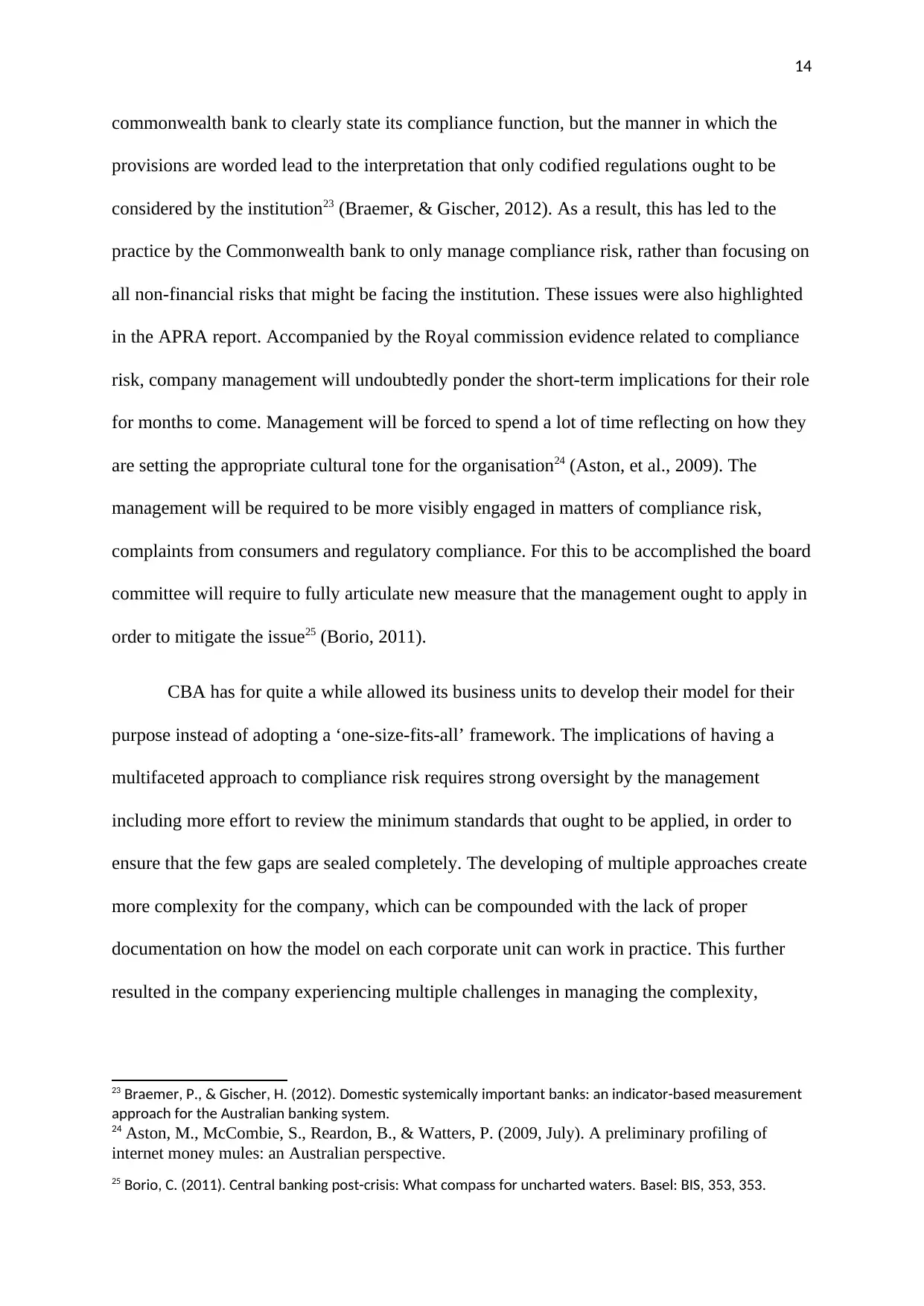
14
commonwealth bank to clearly state its compliance function, but the manner in which the
provisions are worded lead to the interpretation that only codified regulations ought to be
considered by the institution23 (Braemer, & Gischer, 2012). As a result, this has led to the
practice by the Commonwealth bank to only manage compliance risk, rather than focusing on
all non-financial risks that might be facing the institution. These issues were also highlighted
in the APRA report. Accompanied by the Royal commission evidence related to compliance
risk, company management will undoubtedly ponder the short-term implications for their role
for months to come. Management will be forced to spend a lot of time reflecting on how they
are setting the appropriate cultural tone for the organisation24 (Aston, et al., 2009). The
management will be required to be more visibly engaged in matters of compliance risk,
complaints from consumers and regulatory compliance. For this to be accomplished the board
committee will require to fully articulate new measure that the management ought to apply in
order to mitigate the issue25 (Borio, 2011).
CBA has for quite a while allowed its business units to develop their model for their
purpose instead of adopting a ‘one-size-fits-all’ framework. The implications of having a
multifaceted approach to compliance risk requires strong oversight by the management
including more effort to review the minimum standards that ought to be applied, in order to
ensure that the few gaps are sealed completely. The developing of multiple approaches create
more complexity for the company, which can be compounded with the lack of proper
documentation on how the model on each corporate unit can work in practice. This further
resulted in the company experiencing multiple challenges in managing the complexity,
23 Braemer, P., & Gischer, H. (2012). Domestic systemically important banks: an indicator-based measurement
approach for the Australian banking system.
24 Aston, M., McCombie, S., Reardon, B., & Watters, P. (2009, July). A preliminary profiling of
internet money mules: an Australian perspective.
25 Borio, C. (2011). Central banking post-crisis: What compass for uncharted waters. Basel: BIS, 353, 353.
commonwealth bank to clearly state its compliance function, but the manner in which the
provisions are worded lead to the interpretation that only codified regulations ought to be
considered by the institution23 (Braemer, & Gischer, 2012). As a result, this has led to the
practice by the Commonwealth bank to only manage compliance risk, rather than focusing on
all non-financial risks that might be facing the institution. These issues were also highlighted
in the APRA report. Accompanied by the Royal commission evidence related to compliance
risk, company management will undoubtedly ponder the short-term implications for their role
for months to come. Management will be forced to spend a lot of time reflecting on how they
are setting the appropriate cultural tone for the organisation24 (Aston, et al., 2009). The
management will be required to be more visibly engaged in matters of compliance risk,
complaints from consumers and regulatory compliance. For this to be accomplished the board
committee will require to fully articulate new measure that the management ought to apply in
order to mitigate the issue25 (Borio, 2011).
CBA has for quite a while allowed its business units to develop their model for their
purpose instead of adopting a ‘one-size-fits-all’ framework. The implications of having a
multifaceted approach to compliance risk requires strong oversight by the management
including more effort to review the minimum standards that ought to be applied, in order to
ensure that the few gaps are sealed completely. The developing of multiple approaches create
more complexity for the company, which can be compounded with the lack of proper
documentation on how the model on each corporate unit can work in practice. This further
resulted in the company experiencing multiple challenges in managing the complexity,
23 Braemer, P., & Gischer, H. (2012). Domestic systemically important banks: an indicator-based measurement
approach for the Australian banking system.
24 Aston, M., McCombie, S., Reardon, B., & Watters, P. (2009, July). A preliminary profiling of
internet money mules: an Australian perspective.
25 Borio, C. (2011). Central banking post-crisis: What compass for uncharted waters. Basel: BIS, 353, 353.
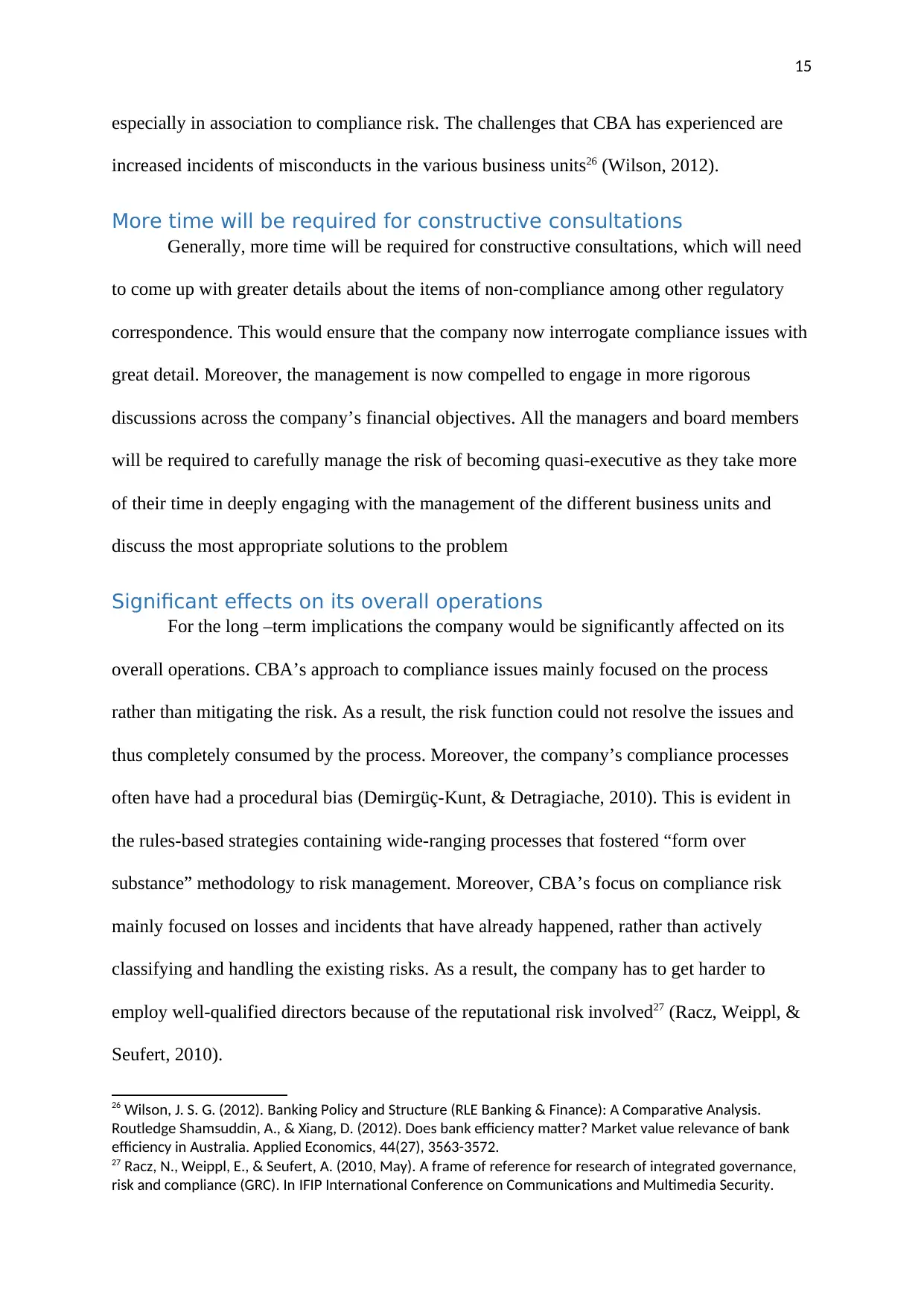
15
especially in association to compliance risk. The challenges that CBA has experienced are
increased incidents of misconducts in the various business units26 (Wilson, 2012).
More time will be required for constructive consultations
Generally, more time will be required for constructive consultations, which will need
to come up with greater details about the items of non-compliance among other regulatory
correspondence. This would ensure that the company now interrogate compliance issues with
great detail. Moreover, the management is now compelled to engage in more rigorous
discussions across the company’s financial objectives. All the managers and board members
will be required to carefully manage the risk of becoming quasi-executive as they take more
of their time in deeply engaging with the management of the different business units and
discuss the most appropriate solutions to the problem
Significant effects on its overall operations
For the long –term implications the company would be significantly affected on its
overall operations. CBA’s approach to compliance issues mainly focused on the process
rather than mitigating the risk. As a result, the risk function could not resolve the issues and
thus completely consumed by the process. Moreover, the company’s compliance processes
often have had a procedural bias (Demirgüç-Kunt, & Detragiache, 2010). This is evident in
the rules-based strategies containing wide-ranging processes that fostered “form over
substance” methodology to risk management. Moreover, CBA’s focus on compliance risk
mainly focused on losses and incidents that have already happened, rather than actively
classifying and handling the existing risks. As a result, the company has to get harder to
employ well-qualified directors because of the reputational risk involved27 (Racz, Weippl, &
Seufert, 2010).
26 Wilson, J. S. G. (2012). Banking Policy and Structure (RLE Banking & Finance): A Comparative Analysis.
Routledge Shamsuddin, A., & Xiang, D. (2012). Does bank efficiency matter? Market value relevance of bank
efficiency in Australia. Applied Economics, 44(27), 3563-3572.
27 Racz, N., Weippl, E., & Seufert, A. (2010, May). A frame of reference for research of integrated governance,
risk and compliance (GRC). In IFIP International Conference on Communications and Multimedia Security.
especially in association to compliance risk. The challenges that CBA has experienced are
increased incidents of misconducts in the various business units26 (Wilson, 2012).
More time will be required for constructive consultations
Generally, more time will be required for constructive consultations, which will need
to come up with greater details about the items of non-compliance among other regulatory
correspondence. This would ensure that the company now interrogate compliance issues with
great detail. Moreover, the management is now compelled to engage in more rigorous
discussions across the company’s financial objectives. All the managers and board members
will be required to carefully manage the risk of becoming quasi-executive as they take more
of their time in deeply engaging with the management of the different business units and
discuss the most appropriate solutions to the problem
Significant effects on its overall operations
For the long –term implications the company would be significantly affected on its
overall operations. CBA’s approach to compliance issues mainly focused on the process
rather than mitigating the risk. As a result, the risk function could not resolve the issues and
thus completely consumed by the process. Moreover, the company’s compliance processes
often have had a procedural bias (Demirgüç-Kunt, & Detragiache, 2010). This is evident in
the rules-based strategies containing wide-ranging processes that fostered “form over
substance” methodology to risk management. Moreover, CBA’s focus on compliance risk
mainly focused on losses and incidents that have already happened, rather than actively
classifying and handling the existing risks. As a result, the company has to get harder to
employ well-qualified directors because of the reputational risk involved27 (Racz, Weippl, &
Seufert, 2010).
26 Wilson, J. S. G. (2012). Banking Policy and Structure (RLE Banking & Finance): A Comparative Analysis.
Routledge Shamsuddin, A., & Xiang, D. (2012). Does bank efficiency matter? Market value relevance of bank
efficiency in Australia. Applied Economics, 44(27), 3563-3572.
27 Racz, N., Weippl, E., & Seufert, A. (2010, May). A frame of reference for research of integrated governance,
risk and compliance (GRC). In IFIP International Conference on Communications and Multimedia Security.
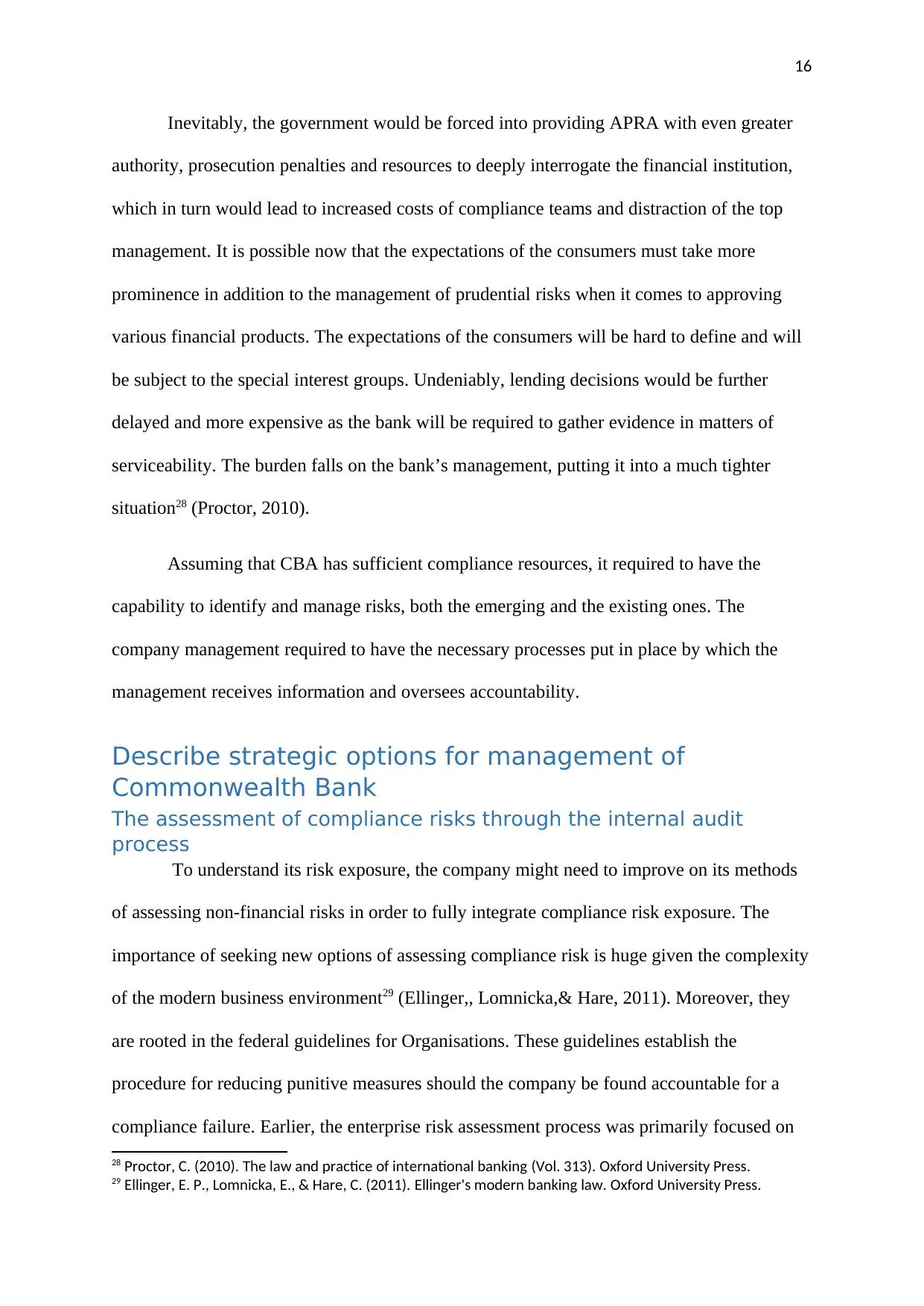
16
Inevitably, the government would be forced into providing APRA with even greater
authority, prosecution penalties and resources to deeply interrogate the financial institution,
which in turn would lead to increased costs of compliance teams and distraction of the top
management. It is possible now that the expectations of the consumers must take more
prominence in addition to the management of prudential risks when it comes to approving
various financial products. The expectations of the consumers will be hard to define and will
be subject to the special interest groups. Undeniably, lending decisions would be further
delayed and more expensive as the bank will be required to gather evidence in matters of
serviceability. The burden falls on the bank’s management, putting it into a much tighter
situation28 (Proctor, 2010).
Assuming that CBA has sufficient compliance resources, it required to have the
capability to identify and manage risks, both the emerging and the existing ones. The
company management required to have the necessary processes put in place by which the
management receives information and oversees accountability.
Describe strategic options for management of
Commonwealth Bank
The assessment of compliance risks through the internal audit
process
To understand its risk exposure, the company might need to improve on its methods
of assessing non-financial risks in order to fully integrate compliance risk exposure. The
importance of seeking new options of assessing compliance risk is huge given the complexity
of the modern business environment29 (Ellinger,, Lomnicka,& Hare, 2011). Moreover, they
are rooted in the federal guidelines for Organisations. These guidelines establish the
procedure for reducing punitive measures should the company be found accountable for a
compliance failure. Earlier, the enterprise risk assessment process was primarily focused on
28 Proctor, C. (2010). The law and practice of international banking (Vol. 313). Oxford University Press.
29 Ellinger, E. P., Lomnicka, E., & Hare, C. (2011). Ellinger's modern banking law. Oxford University Press.
Inevitably, the government would be forced into providing APRA with even greater
authority, prosecution penalties and resources to deeply interrogate the financial institution,
which in turn would lead to increased costs of compliance teams and distraction of the top
management. It is possible now that the expectations of the consumers must take more
prominence in addition to the management of prudential risks when it comes to approving
various financial products. The expectations of the consumers will be hard to define and will
be subject to the special interest groups. Undeniably, lending decisions would be further
delayed and more expensive as the bank will be required to gather evidence in matters of
serviceability. The burden falls on the bank’s management, putting it into a much tighter
situation28 (Proctor, 2010).
Assuming that CBA has sufficient compliance resources, it required to have the
capability to identify and manage risks, both the emerging and the existing ones. The
company management required to have the necessary processes put in place by which the
management receives information and oversees accountability.
Describe strategic options for management of
Commonwealth Bank
The assessment of compliance risks through the internal audit
process
To understand its risk exposure, the company might need to improve on its methods
of assessing non-financial risks in order to fully integrate compliance risk exposure. The
importance of seeking new options of assessing compliance risk is huge given the complexity
of the modern business environment29 (Ellinger,, Lomnicka,& Hare, 2011). Moreover, they
are rooted in the federal guidelines for Organisations. These guidelines establish the
procedure for reducing punitive measures should the company be found accountable for a
compliance failure. Earlier, the enterprise risk assessment process was primarily focused on
28 Proctor, C. (2010). The law and practice of international banking (Vol. 313). Oxford University Press.
29 Ellinger, E. P., Lomnicka, E., & Hare, C. (2011). Ellinger's modern banking law. Oxford University Press.
Secure Best Marks with AI Grader
Need help grading? Try our AI Grader for instant feedback on your assignments.
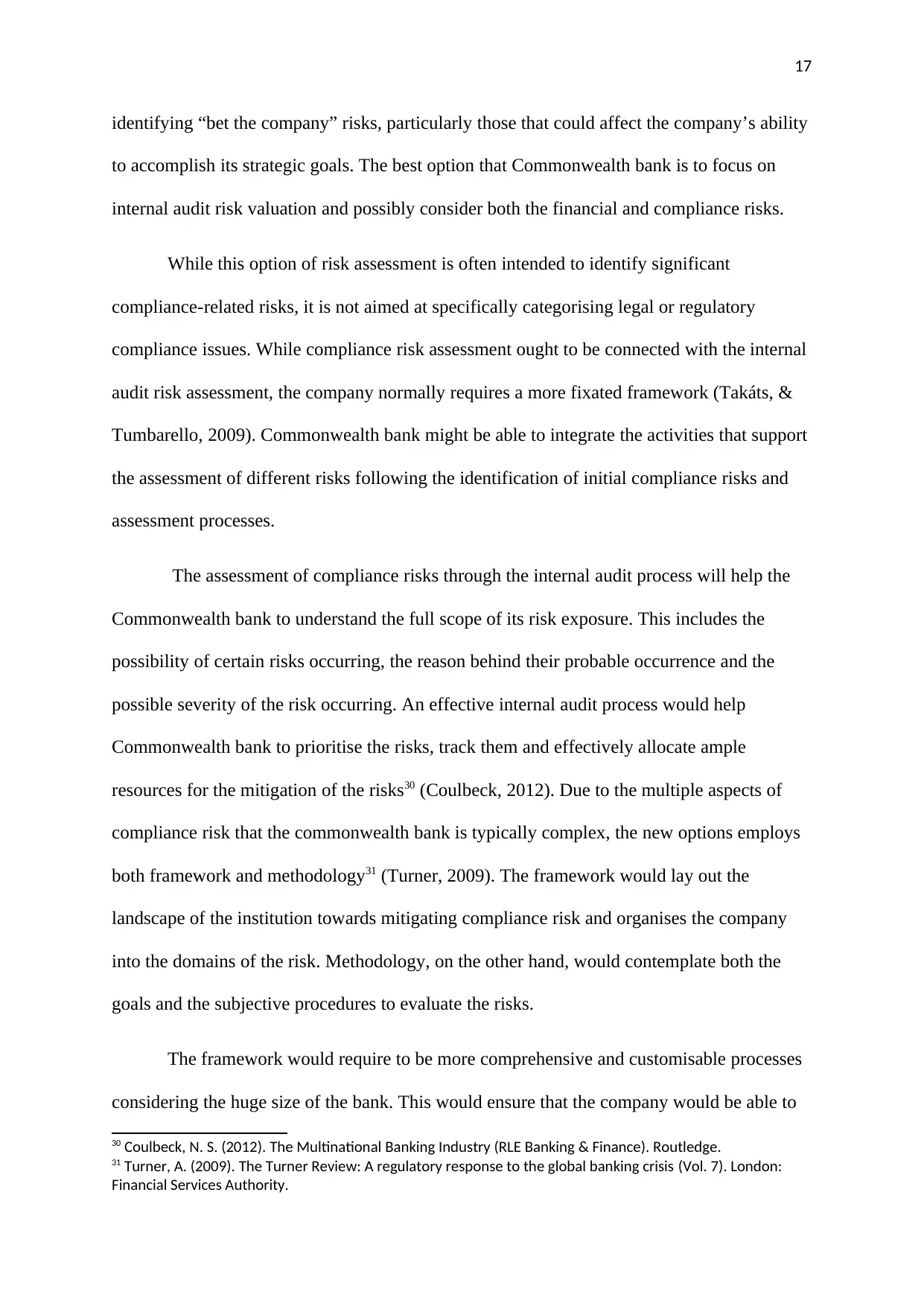
17
identifying “bet the company” risks, particularly those that could affect the company’s ability
to accomplish its strategic goals. The best option that Commonwealth bank is to focus on
internal audit risk valuation and possibly consider both the financial and compliance risks.
While this option of risk assessment is often intended to identify significant
compliance-related risks, it is not aimed at specifically categorising legal or regulatory
compliance issues. While compliance risk assessment ought to be connected with the internal
audit risk assessment, the company normally requires a more fixated framework (Takáts, &
Tumbarello, 2009). Commonwealth bank might be able to integrate the activities that support
the assessment of different risks following the identification of initial compliance risks and
assessment processes.
The assessment of compliance risks through the internal audit process will help the
Commonwealth bank to understand the full scope of its risk exposure. This includes the
possibility of certain risks occurring, the reason behind their probable occurrence and the
possible severity of the risk occurring. An effective internal audit process would help
Commonwealth bank to prioritise the risks, track them and effectively allocate ample
resources for the mitigation of the risks30 (Coulbeck, 2012). Due to the multiple aspects of
compliance risk that the commonwealth bank is typically complex, the new options employs
both framework and methodology31 (Turner, 2009). The framework would lay out the
landscape of the institution towards mitigating compliance risk and organises the company
into the domains of the risk. Methodology, on the other hand, would contemplate both the
goals and the subjective procedures to evaluate the risks.
The framework would require to be more comprehensive and customisable processes
considering the huge size of the bank. This would ensure that the company would be able to
30 Coulbeck, N. S. (2012). The Multinational Banking Industry (RLE Banking & Finance). Routledge.
31 Turner, A. (2009). The Turner Review: A regulatory response to the global banking crisis (Vol. 7). London:
Financial Services Authority.
identifying “bet the company” risks, particularly those that could affect the company’s ability
to accomplish its strategic goals. The best option that Commonwealth bank is to focus on
internal audit risk valuation and possibly consider both the financial and compliance risks.
While this option of risk assessment is often intended to identify significant
compliance-related risks, it is not aimed at specifically categorising legal or regulatory
compliance issues. While compliance risk assessment ought to be connected with the internal
audit risk assessment, the company normally requires a more fixated framework (Takáts, &
Tumbarello, 2009). Commonwealth bank might be able to integrate the activities that support
the assessment of different risks following the identification of initial compliance risks and
assessment processes.
The assessment of compliance risks through the internal audit process will help the
Commonwealth bank to understand the full scope of its risk exposure. This includes the
possibility of certain risks occurring, the reason behind their probable occurrence and the
possible severity of the risk occurring. An effective internal audit process would help
Commonwealth bank to prioritise the risks, track them and effectively allocate ample
resources for the mitigation of the risks30 (Coulbeck, 2012). Due to the multiple aspects of
compliance risk that the commonwealth bank is typically complex, the new options employs
both framework and methodology31 (Turner, 2009). The framework would lay out the
landscape of the institution towards mitigating compliance risk and organises the company
into the domains of the risk. Methodology, on the other hand, would contemplate both the
goals and the subjective procedures to evaluate the risks.
The framework would require to be more comprehensive and customisable processes
considering the huge size of the bank. This would ensure that the company would be able to
30 Coulbeck, N. S. (2012). The Multinational Banking Industry (RLE Banking & Finance). Routledge.
31 Turner, A. (2009). The Turner Review: A regulatory response to the global banking crisis (Vol. 7). London:
Financial Services Authority.
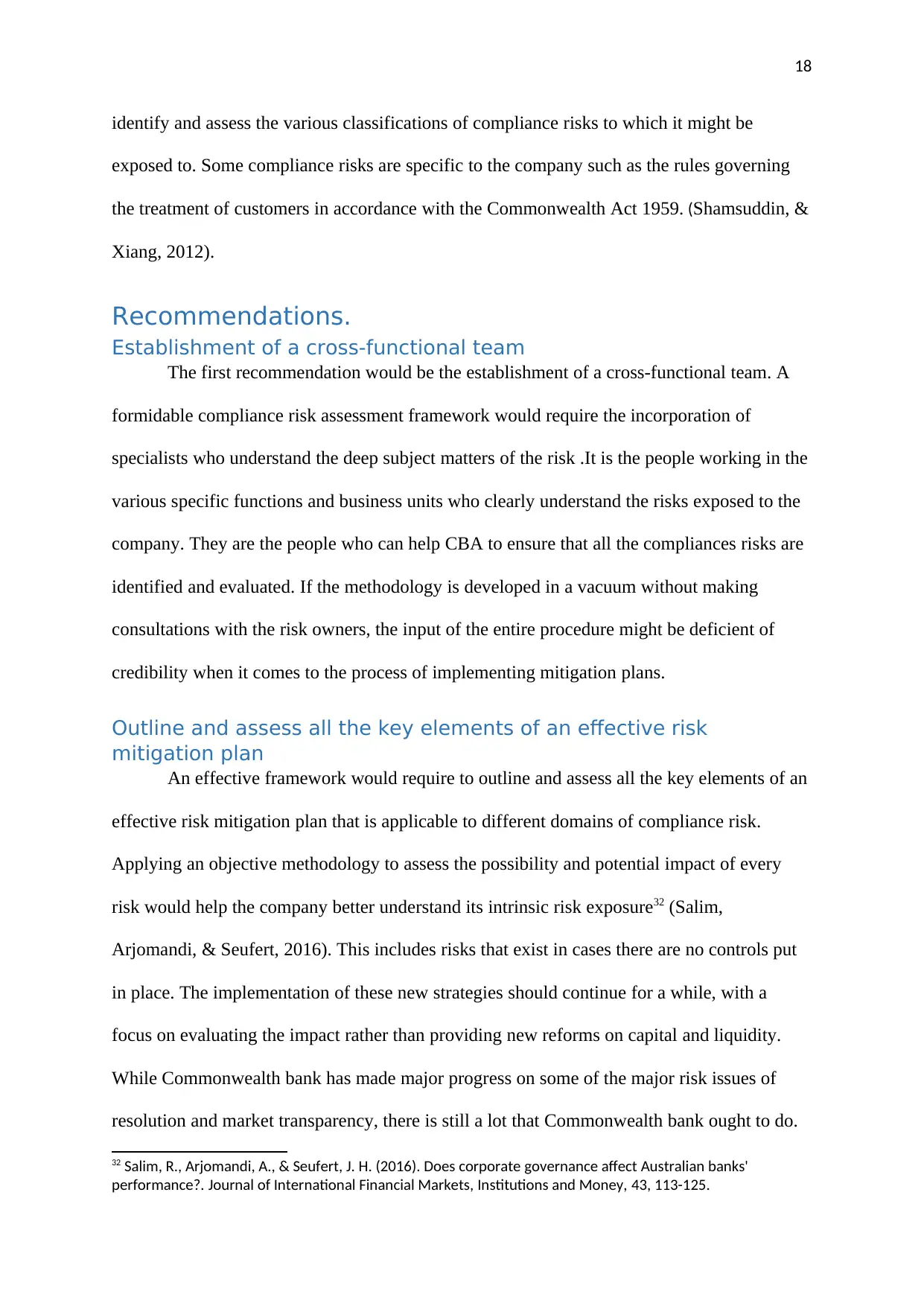
18
identify and assess the various classifications of compliance risks to which it might be
exposed to. Some compliance risks are specific to the company such as the rules governing
the treatment of customers in accordance with the Commonwealth Act 1959. (Shamsuddin, &
Xiang, 2012).
Recommendations.
Establishment of a cross-functional team
The first recommendation would be the establishment of a cross-functional team. A
formidable compliance risk assessment framework would require the incorporation of
specialists who understand the deep subject matters of the risk .It is the people working in the
various specific functions and business units who clearly understand the risks exposed to the
company. They are the people who can help CBA to ensure that all the compliances risks are
identified and evaluated. If the methodology is developed in a vacuum without making
consultations with the risk owners, the input of the entire procedure might be deficient of
credibility when it comes to the process of implementing mitigation plans.
Outline and assess all the key elements of an effective risk
mitigation plan
An effective framework would require to outline and assess all the key elements of an
effective risk mitigation plan that is applicable to different domains of compliance risk.
Applying an objective methodology to assess the possibility and potential impact of every
risk would help the company better understand its intrinsic risk exposure32 (Salim,
Arjomandi, & Seufert, 2016). This includes risks that exist in cases there are no controls put
in place. The implementation of these new strategies should continue for a while, with a
focus on evaluating the impact rather than providing new reforms on capital and liquidity.
While Commonwealth bank has made major progress on some of the major risk issues of
resolution and market transparency, there is still a lot that Commonwealth bank ought to do.
32 Salim, R., Arjomandi, A., & Seufert, J. H. (2016). Does corporate governance affect Australian banks'
performance?. Journal of International Financial Markets, Institutions and Money, 43, 113-125.
identify and assess the various classifications of compliance risks to which it might be
exposed to. Some compliance risks are specific to the company such as the rules governing
the treatment of customers in accordance with the Commonwealth Act 1959. (Shamsuddin, &
Xiang, 2012).
Recommendations.
Establishment of a cross-functional team
The first recommendation would be the establishment of a cross-functional team. A
formidable compliance risk assessment framework would require the incorporation of
specialists who understand the deep subject matters of the risk .It is the people working in the
various specific functions and business units who clearly understand the risks exposed to the
company. They are the people who can help CBA to ensure that all the compliances risks are
identified and evaluated. If the methodology is developed in a vacuum without making
consultations with the risk owners, the input of the entire procedure might be deficient of
credibility when it comes to the process of implementing mitigation plans.
Outline and assess all the key elements of an effective risk
mitigation plan
An effective framework would require to outline and assess all the key elements of an
effective risk mitigation plan that is applicable to different domains of compliance risk.
Applying an objective methodology to assess the possibility and potential impact of every
risk would help the company better understand its intrinsic risk exposure32 (Salim,
Arjomandi, & Seufert, 2016). This includes risks that exist in cases there are no controls put
in place. The implementation of these new strategies should continue for a while, with a
focus on evaluating the impact rather than providing new reforms on capital and liquidity.
While Commonwealth bank has made major progress on some of the major risk issues of
resolution and market transparency, there is still a lot that Commonwealth bank ought to do.
32 Salim, R., Arjomandi, A., & Seufert, J. H. (2016). Does corporate governance affect Australian banks'
performance?. Journal of International Financial Markets, Institutions and Money, 43, 113-125.
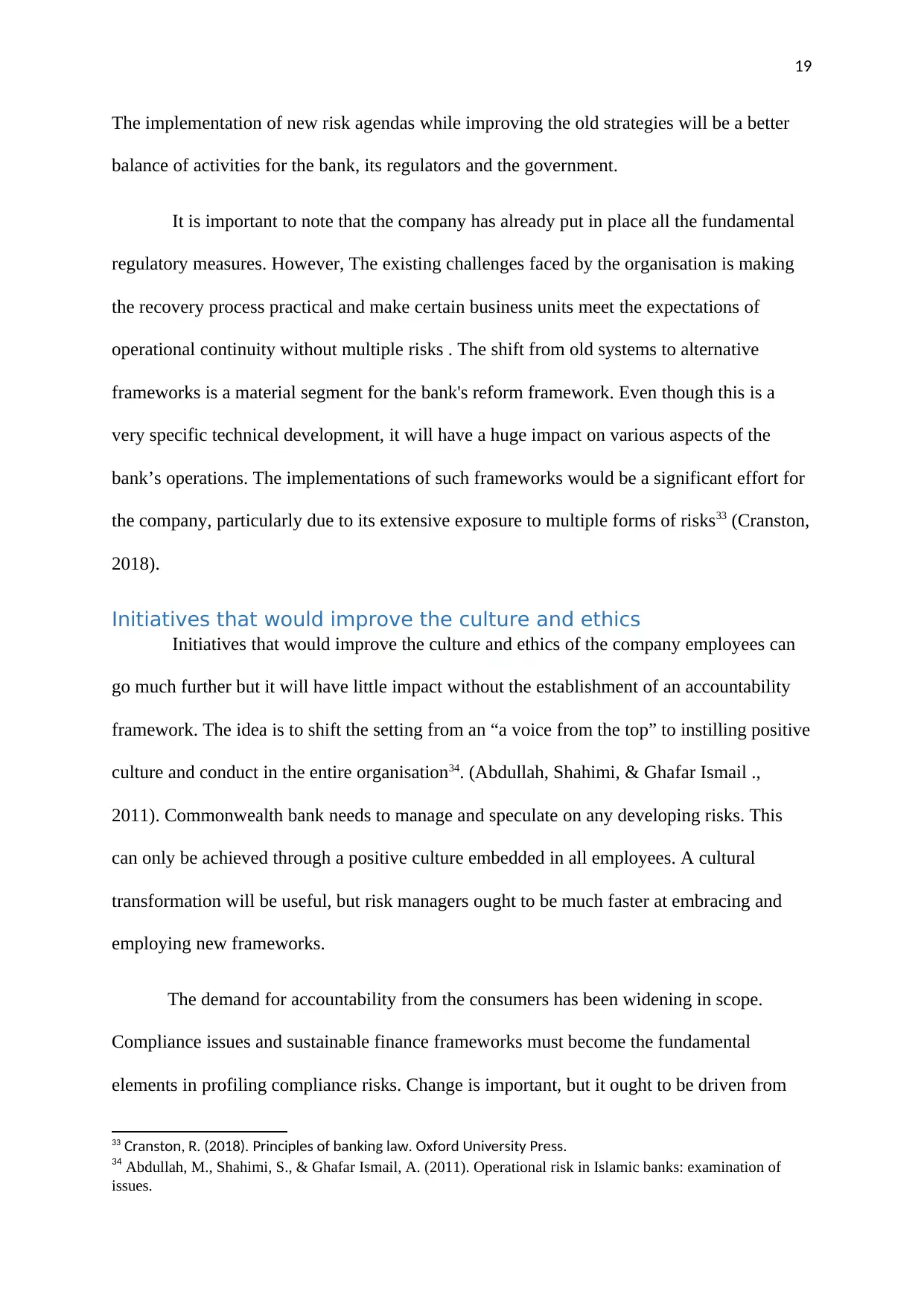
19
The implementation of new risk agendas while improving the old strategies will be a better
balance of activities for the bank, its regulators and the government.
It is important to note that the company has already put in place all the fundamental
regulatory measures. However, The existing challenges faced by the organisation is making
the recovery process practical and make certain business units meet the expectations of
operational continuity without multiple risks . The shift from old systems to alternative
frameworks is a material segment for the bank's reform framework. Even though this is a
very specific technical development, it will have a huge impact on various aspects of the
bank’s operations. The implementations of such frameworks would be a significant effort for
the company, particularly due to its extensive exposure to multiple forms of risks33 (Cranston,
2018).
Initiatives that would improve the culture and ethics
Initiatives that would improve the culture and ethics of the company employees can
go much further but it will have little impact without the establishment of an accountability
framework. The idea is to shift the setting from an “a voice from the top” to instilling positive
culture and conduct in the entire organisation34. (Abdullah, Shahimi, & Ghafar Ismail .,
2011). Commonwealth bank needs to manage and speculate on any developing risks. This
can only be achieved through a positive culture embedded in all employees. A cultural
transformation will be useful, but risk managers ought to be much faster at embracing and
employing new frameworks.
The demand for accountability from the consumers has been widening in scope.
Compliance issues and sustainable finance frameworks must become the fundamental
elements in profiling compliance risks. Change is important, but it ought to be driven from
33 Cranston, R. (2018). Principles of banking law. Oxford University Press.
34 Abdullah, M., Shahimi, S., & Ghafar Ismail, A. (2011). Operational risk in Islamic banks: examination of
issues.
The implementation of new risk agendas while improving the old strategies will be a better
balance of activities for the bank, its regulators and the government.
It is important to note that the company has already put in place all the fundamental
regulatory measures. However, The existing challenges faced by the organisation is making
the recovery process practical and make certain business units meet the expectations of
operational continuity without multiple risks . The shift from old systems to alternative
frameworks is a material segment for the bank's reform framework. Even though this is a
very specific technical development, it will have a huge impact on various aspects of the
bank’s operations. The implementations of such frameworks would be a significant effort for
the company, particularly due to its extensive exposure to multiple forms of risks33 (Cranston,
2018).
Initiatives that would improve the culture and ethics
Initiatives that would improve the culture and ethics of the company employees can
go much further but it will have little impact without the establishment of an accountability
framework. The idea is to shift the setting from an “a voice from the top” to instilling positive
culture and conduct in the entire organisation34. (Abdullah, Shahimi, & Ghafar Ismail .,
2011). Commonwealth bank needs to manage and speculate on any developing risks. This
can only be achieved through a positive culture embedded in all employees. A cultural
transformation will be useful, but risk managers ought to be much faster at embracing and
employing new frameworks.
The demand for accountability from the consumers has been widening in scope.
Compliance issues and sustainable finance frameworks must become the fundamental
elements in profiling compliance risks. Change is important, but it ought to be driven from
33 Cranston, R. (2018). Principles of banking law. Oxford University Press.
34 Abdullah, M., Shahimi, S., & Ghafar Ismail, A. (2011). Operational risk in Islamic banks: examination of
issues.
Paraphrase This Document
Need a fresh take? Get an instant paraphrase of this document with our AI Paraphraser
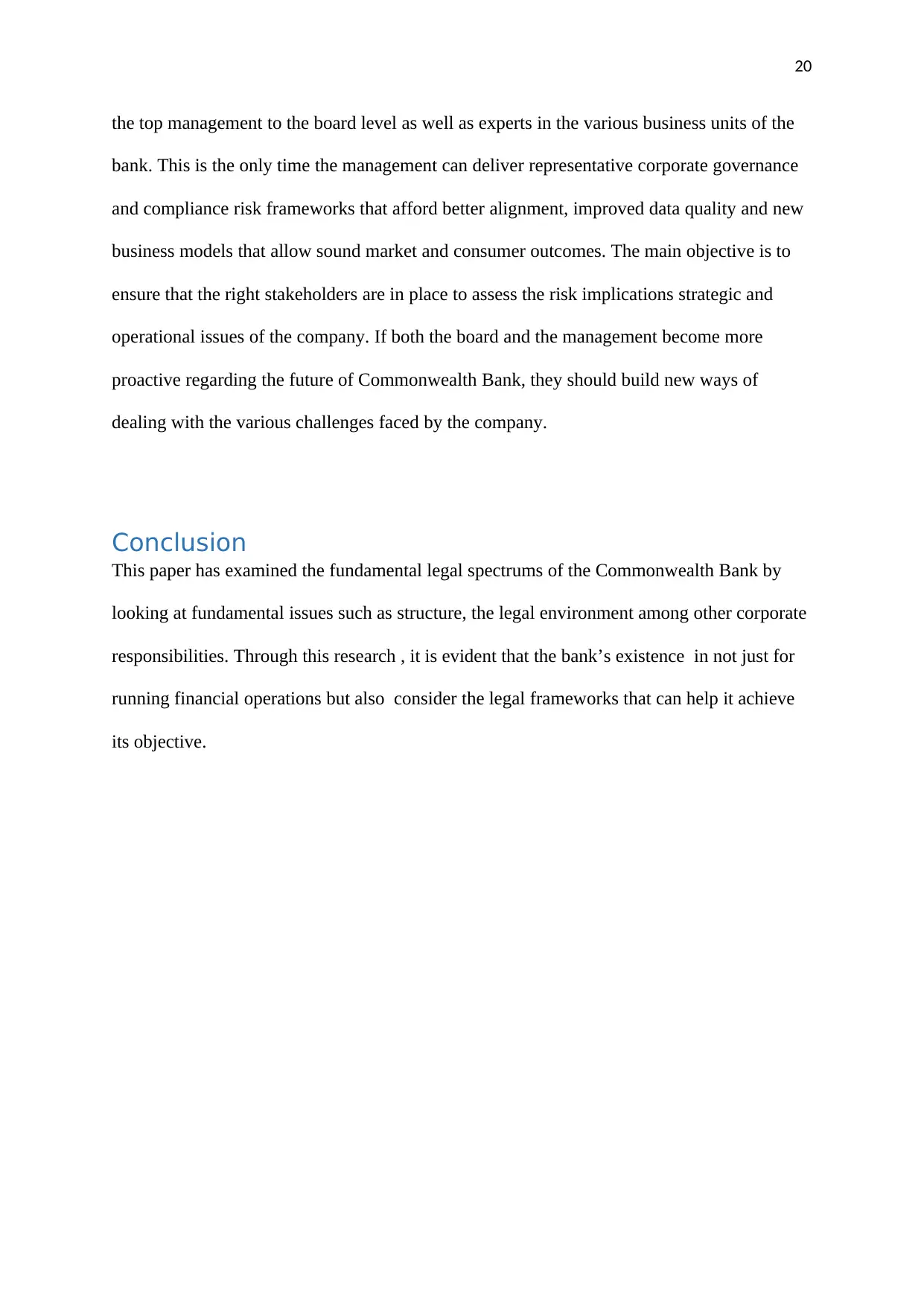
20
the top management to the board level as well as experts in the various business units of the
bank. This is the only time the management can deliver representative corporate governance
and compliance risk frameworks that afford better alignment, improved data quality and new
business models that allow sound market and consumer outcomes. The main objective is to
ensure that the right stakeholders are in place to assess the risk implications strategic and
operational issues of the company. If both the board and the management become more
proactive regarding the future of Commonwealth Bank, they should build new ways of
dealing with the various challenges faced by the company.
Conclusion
This paper has examined the fundamental legal spectrums of the Commonwealth Bank by
looking at fundamental issues such as structure, the legal environment among other corporate
responsibilities. Through this research , it is evident that the bank’s existence in not just for
running financial operations but also consider the legal frameworks that can help it achieve
its objective.
the top management to the board level as well as experts in the various business units of the
bank. This is the only time the management can deliver representative corporate governance
and compliance risk frameworks that afford better alignment, improved data quality and new
business models that allow sound market and consumer outcomes. The main objective is to
ensure that the right stakeholders are in place to assess the risk implications strategic and
operational issues of the company. If both the board and the management become more
proactive regarding the future of Commonwealth Bank, they should build new ways of
dealing with the various challenges faced by the company.
Conclusion
This paper has examined the fundamental legal spectrums of the Commonwealth Bank by
looking at fundamental issues such as structure, the legal environment among other corporate
responsibilities. Through this research , it is evident that the bank’s existence in not just for
running financial operations but also consider the legal frameworks that can help it achieve
its objective.
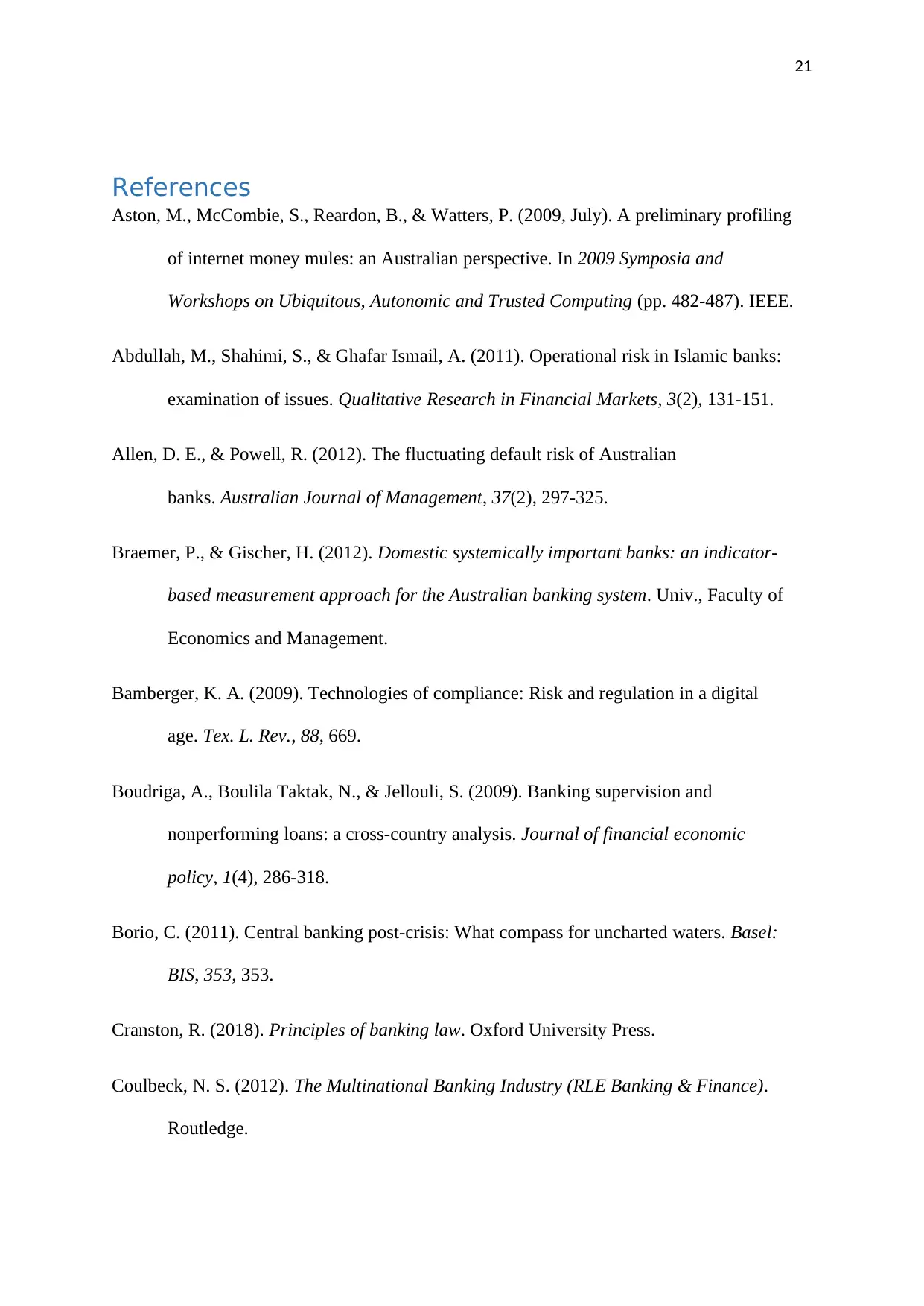
21
References
Aston, M., McCombie, S., Reardon, B., & Watters, P. (2009, July). A preliminary profiling
of internet money mules: an Australian perspective. In 2009 Symposia and
Workshops on Ubiquitous, Autonomic and Trusted Computing (pp. 482-487). IEEE.
Abdullah, M., Shahimi, S., & Ghafar Ismail, A. (2011). Operational risk in Islamic banks:
examination of issues. Qualitative Research in Financial Markets, 3(2), 131-151.
Allen, D. E., & Powell, R. (2012). The fluctuating default risk of Australian
banks. Australian Journal of Management, 37(2), 297-325.
Braemer, P., & Gischer, H. (2012). Domestic systemically important banks: an indicator-
based measurement approach for the Australian banking system. Univ., Faculty of
Economics and Management.
Bamberger, K. A. (2009). Technologies of compliance: Risk and regulation in a digital
age. Tex. L. Rev., 88, 669.
Boudriga, A., Boulila Taktak, N., & Jellouli, S. (2009). Banking supervision and
nonperforming loans: a cross-country analysis. Journal of financial economic
policy, 1(4), 286-318.
Borio, C. (2011). Central banking post-crisis: What compass for uncharted waters. Basel:
BIS, 353, 353.
Cranston, R. (2018). Principles of banking law. Oxford University Press.
Coulbeck, N. S. (2012). The Multinational Banking Industry (RLE Banking & Finance).
Routledge.
References
Aston, M., McCombie, S., Reardon, B., & Watters, P. (2009, July). A preliminary profiling
of internet money mules: an Australian perspective. In 2009 Symposia and
Workshops on Ubiquitous, Autonomic and Trusted Computing (pp. 482-487). IEEE.
Abdullah, M., Shahimi, S., & Ghafar Ismail, A. (2011). Operational risk in Islamic banks:
examination of issues. Qualitative Research in Financial Markets, 3(2), 131-151.
Allen, D. E., & Powell, R. (2012). The fluctuating default risk of Australian
banks. Australian Journal of Management, 37(2), 297-325.
Braemer, P., & Gischer, H. (2012). Domestic systemically important banks: an indicator-
based measurement approach for the Australian banking system. Univ., Faculty of
Economics and Management.
Bamberger, K. A. (2009). Technologies of compliance: Risk and regulation in a digital
age. Tex. L. Rev., 88, 669.
Boudriga, A., Boulila Taktak, N., & Jellouli, S. (2009). Banking supervision and
nonperforming loans: a cross-country analysis. Journal of financial economic
policy, 1(4), 286-318.
Borio, C. (2011). Central banking post-crisis: What compass for uncharted waters. Basel:
BIS, 353, 353.
Cranston, R. (2018). Principles of banking law. Oxford University Press.
Coulbeck, N. S. (2012). The Multinational Banking Industry (RLE Banking & Finance).
Routledge.
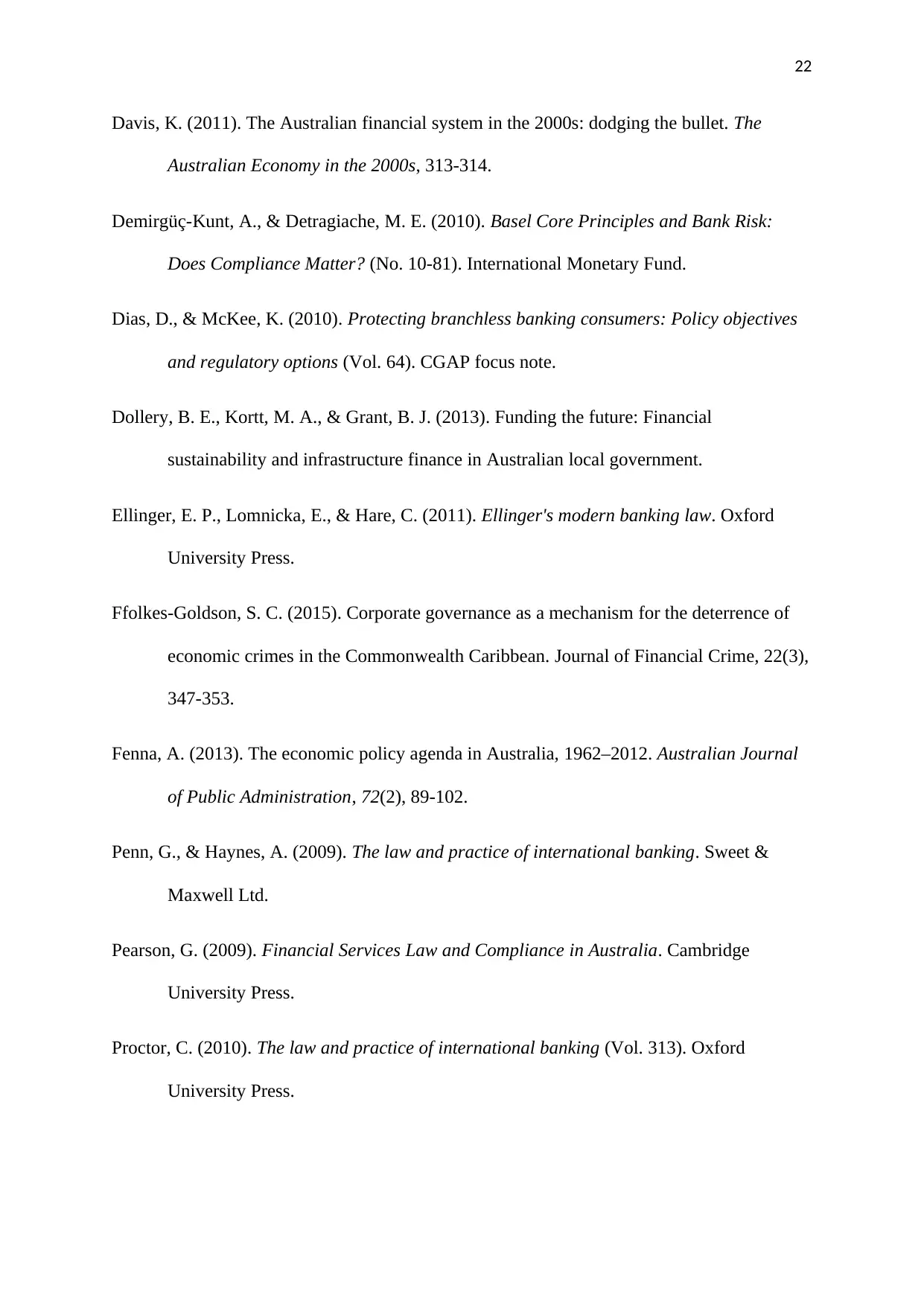
22
Davis, K. (2011). The Australian financial system in the 2000s: dodging the bullet. The
Australian Economy in the 2000s, 313-314.
Demirgüç-Kunt, A., & Detragiache, M. E. (2010). Basel Core Principles and Bank Risk:
Does Compliance Matter? (No. 10-81). International Monetary Fund.
Dias, D., & McKee, K. (2010). Protecting branchless banking consumers: Policy objectives
and regulatory options (Vol. 64). CGAP focus note.
Dollery, B. E., Kortt, M. A., & Grant, B. J. (2013). Funding the future: Financial
sustainability and infrastructure finance in Australian local government.
Ellinger, E. P., Lomnicka, E., & Hare, C. (2011). Ellinger's modern banking law. Oxford
University Press.
Ffolkes-Goldson, S. C. (2015). Corporate governance as a mechanism for the deterrence of
economic crimes in the Commonwealth Caribbean. Journal of Financial Crime, 22(3),
347-353.
Fenna, A. (2013). The economic policy agenda in Australia, 1962–2012. Australian Journal
of Public Administration, 72(2), 89-102.
Penn, G., & Haynes, A. (2009). The law and practice of international banking. Sweet &
Maxwell Ltd.
Pearson, G. (2009). Financial Services Law and Compliance in Australia. Cambridge
University Press.
Proctor, C. (2010). The law and practice of international banking (Vol. 313). Oxford
University Press.
Davis, K. (2011). The Australian financial system in the 2000s: dodging the bullet. The
Australian Economy in the 2000s, 313-314.
Demirgüç-Kunt, A., & Detragiache, M. E. (2010). Basel Core Principles and Bank Risk:
Does Compliance Matter? (No. 10-81). International Monetary Fund.
Dias, D., & McKee, K. (2010). Protecting branchless banking consumers: Policy objectives
and regulatory options (Vol. 64). CGAP focus note.
Dollery, B. E., Kortt, M. A., & Grant, B. J. (2013). Funding the future: Financial
sustainability and infrastructure finance in Australian local government.
Ellinger, E. P., Lomnicka, E., & Hare, C. (2011). Ellinger's modern banking law. Oxford
University Press.
Ffolkes-Goldson, S. C. (2015). Corporate governance as a mechanism for the deterrence of
economic crimes in the Commonwealth Caribbean. Journal of Financial Crime, 22(3),
347-353.
Fenna, A. (2013). The economic policy agenda in Australia, 1962–2012. Australian Journal
of Public Administration, 72(2), 89-102.
Penn, G., & Haynes, A. (2009). The law and practice of international banking. Sweet &
Maxwell Ltd.
Pearson, G. (2009). Financial Services Law and Compliance in Australia. Cambridge
University Press.
Proctor, C. (2010). The law and practice of international banking (Vol. 313). Oxford
University Press.
Secure Best Marks with AI Grader
Need help grading? Try our AI Grader for instant feedback on your assignments.
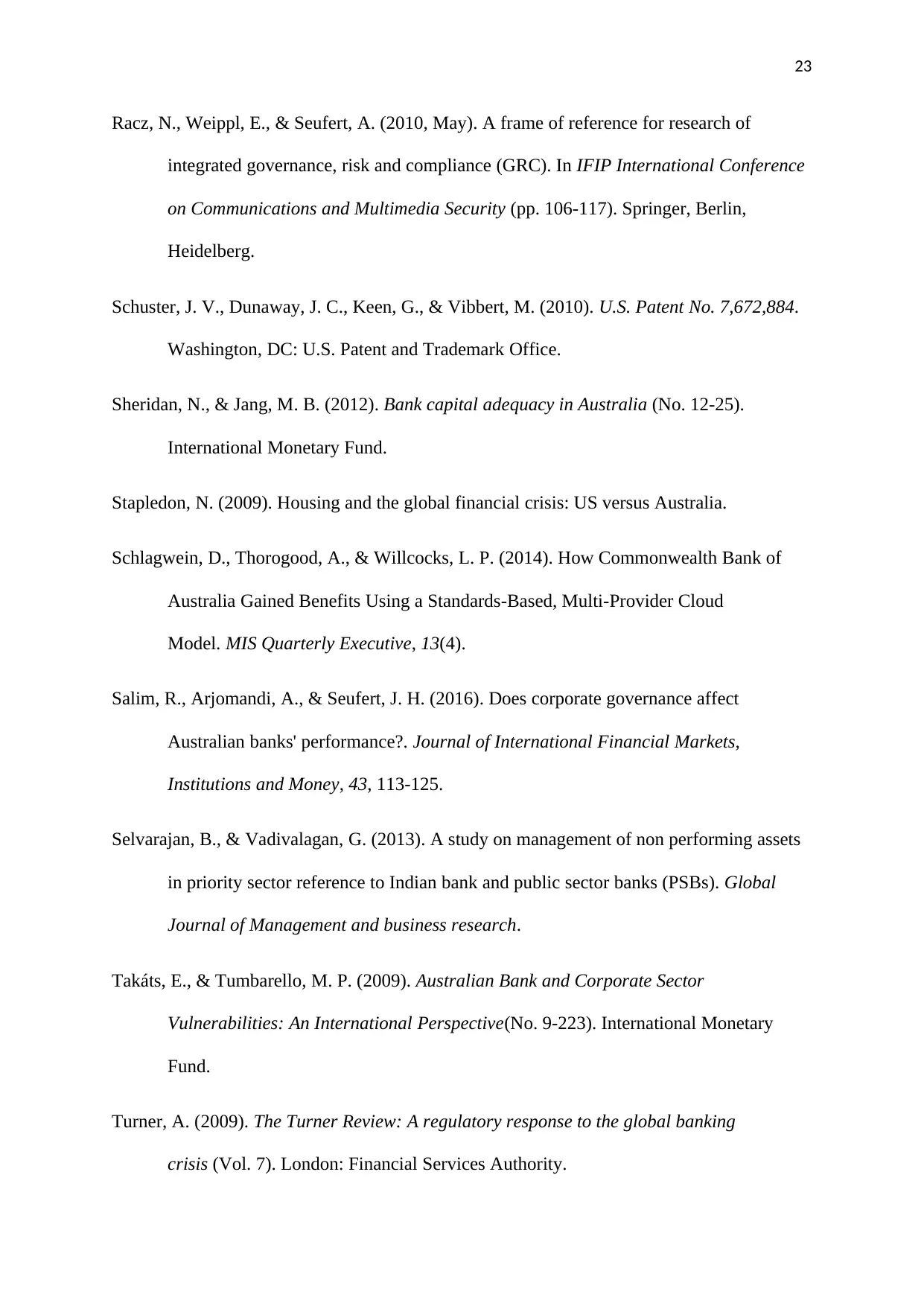
23
Racz, N., Weippl, E., & Seufert, A. (2010, May). A frame of reference for research of
integrated governance, risk and compliance (GRC). In IFIP International Conference
on Communications and Multimedia Security (pp. 106-117). Springer, Berlin,
Heidelberg.
Schuster, J. V., Dunaway, J. C., Keen, G., & Vibbert, M. (2010). U.S. Patent No. 7,672,884.
Washington, DC: U.S. Patent and Trademark Office.
Sheridan, N., & Jang, M. B. (2012). Bank capital adequacy in Australia (No. 12-25).
International Monetary Fund.
Stapledon, N. (2009). Housing and the global financial crisis: US versus Australia.
Schlagwein, D., Thorogood, A., & Willcocks, L. P. (2014). How Commonwealth Bank of
Australia Gained Benefits Using a Standards-Based, Multi-Provider Cloud
Model. MIS Quarterly Executive, 13(4).
Salim, R., Arjomandi, A., & Seufert, J. H. (2016). Does corporate governance affect
Australian banks' performance?. Journal of International Financial Markets,
Institutions and Money, 43, 113-125.
Selvarajan, B., & Vadivalagan, G. (2013). A study on management of non performing assets
in priority sector reference to Indian bank and public sector banks (PSBs). Global
Journal of Management and business research.
Takáts, E., & Tumbarello, M. P. (2009). Australian Bank and Corporate Sector
Vulnerabilities: An International Perspective(No. 9-223). International Monetary
Fund.
Turner, A. (2009). The Turner Review: A regulatory response to the global banking
crisis (Vol. 7). London: Financial Services Authority.
Racz, N., Weippl, E., & Seufert, A. (2010, May). A frame of reference for research of
integrated governance, risk and compliance (GRC). In IFIP International Conference
on Communications and Multimedia Security (pp. 106-117). Springer, Berlin,
Heidelberg.
Schuster, J. V., Dunaway, J. C., Keen, G., & Vibbert, M. (2010). U.S. Patent No. 7,672,884.
Washington, DC: U.S. Patent and Trademark Office.
Sheridan, N., & Jang, M. B. (2012). Bank capital adequacy in Australia (No. 12-25).
International Monetary Fund.
Stapledon, N. (2009). Housing and the global financial crisis: US versus Australia.
Schlagwein, D., Thorogood, A., & Willcocks, L. P. (2014). How Commonwealth Bank of
Australia Gained Benefits Using a Standards-Based, Multi-Provider Cloud
Model. MIS Quarterly Executive, 13(4).
Salim, R., Arjomandi, A., & Seufert, J. H. (2016). Does corporate governance affect
Australian banks' performance?. Journal of International Financial Markets,
Institutions and Money, 43, 113-125.
Selvarajan, B., & Vadivalagan, G. (2013). A study on management of non performing assets
in priority sector reference to Indian bank and public sector banks (PSBs). Global
Journal of Management and business research.
Takáts, E., & Tumbarello, M. P. (2009). Australian Bank and Corporate Sector
Vulnerabilities: An International Perspective(No. 9-223). International Monetary
Fund.
Turner, A. (2009). The Turner Review: A regulatory response to the global banking
crisis (Vol. 7). London: Financial Services Authority.
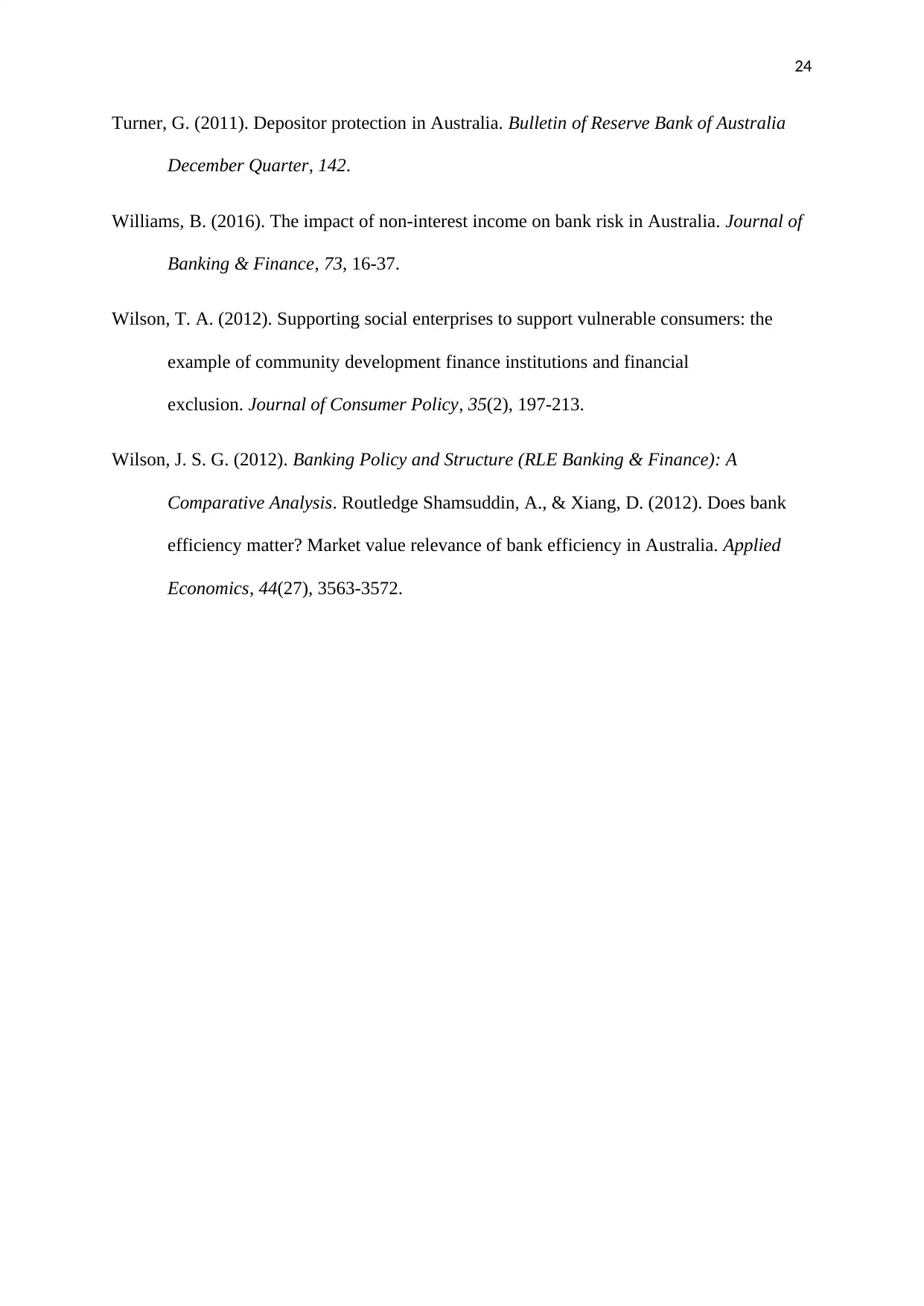
24
Turner, G. (2011). Depositor protection in Australia. Bulletin of Reserve Bank of Australia
December Quarter, 142.
Williams, B. (2016). The impact of non-interest income on bank risk in Australia. Journal of
Banking & Finance, 73, 16-37.
Wilson, T. A. (2012). Supporting social enterprises to support vulnerable consumers: the
example of community development finance institutions and financial
exclusion. Journal of Consumer Policy, 35(2), 197-213.
Wilson, J. S. G. (2012). Banking Policy and Structure (RLE Banking & Finance): A
Comparative Analysis. Routledge Shamsuddin, A., & Xiang, D. (2012). Does bank
efficiency matter? Market value relevance of bank efficiency in Australia. Applied
Economics, 44(27), 3563-3572.
Turner, G. (2011). Depositor protection in Australia. Bulletin of Reserve Bank of Australia
December Quarter, 142.
Williams, B. (2016). The impact of non-interest income on bank risk in Australia. Journal of
Banking & Finance, 73, 16-37.
Wilson, T. A. (2012). Supporting social enterprises to support vulnerable consumers: the
example of community development finance institutions and financial
exclusion. Journal of Consumer Policy, 35(2), 197-213.
Wilson, J. S. G. (2012). Banking Policy and Structure (RLE Banking & Finance): A
Comparative Analysis. Routledge Shamsuddin, A., & Xiang, D. (2012). Does bank
efficiency matter? Market value relevance of bank efficiency in Australia. Applied
Economics, 44(27), 3563-3572.
1 out of 24
Related Documents
Your All-in-One AI-Powered Toolkit for Academic Success.
+13062052269
info@desklib.com
Available 24*7 on WhatsApp / Email
![[object Object]](/_next/static/media/star-bottom.7253800d.svg)
Unlock your academic potential
© 2024 | Zucol Services PVT LTD | All rights reserved.





